lordroel
Administrator
Posts: 68,093 
Likes: 49,488
|
Post by lordroel on Dec 12, 2020 14:33:48 GMT
Day 834 of World War II, December 12th 1941YouTube (Hitler Declares War on the USA and the Jews)Battle of the MediterraneanItalian cruisers Alberto da Giussano & Alberico da Barbiano depart Palermo, Sicily, for Tripoli, Libya, carrying 135 troops, 900 tons of food and fuel in large drums on deck (100 tons of gasoline, 250 tons of diesel fuel & 600 tons of fuel oil) for Rommel. Western Desert Campaign - Operation CrusaderGerman and Italian forces under General Erwin Rommel have withdrawn in good order into a line centered around Gazala. The 5th New Zealand Infantry Brigade closes up on this new Gazala line. One veteran in the unit writes: ‘… So steady was the advance that the gunners could not range quickly enough with the result that the shells were bursting behind our line, though to me it seemed that several direct hits were made on the right flank but the boys came out of the smoke and dust still in line, never faltering. It was a magnificent sight to see that thin line moving steadily forward into a hail of lead, with shells of all sizes … bursting all around…. the fact that the ground was sandy saved more casualties…. One more dash brought us to within bayonet reach. We crossed the ground swiftly, some of the boys shouting encouragement to each other. From my position on the left flank, I could see our line, straight enough to bring joy to any bayonet instructor, stretching away to the right flank. Roaring “Forward!”, I came up ready for the final dash. It made the blood sing to see the boys leap forward, a steady line of gleaming steel backed by grim faces. Nothing short of death could stop them now.’Pacific WarPHILIPPINE ISLANDS LUZON - More than 100 Japanese aircraft hit targets at Clark Field, Batangas, and Olongapo on Luzon Island. No hits are scored by the single B-17 that is sent against Japanese transports at Vigan. The 3d Pursuit Squadron (Interceptor), 24th Pursuit Group (Interceptor), transfers from Nichols Field to Ternate, Luzon and operating from Del Carmon, Luzon with P-40's. Japanese forces begin landing on Luzon Photo: On December 12, 1941, at the foot of the Mayon Volcano, Type 97 Carrier Attack Bombers (B5N1) "Kate" from the aircraft carrier Ryujo sprang forth its attack on Legaspi, southeastern part of Luzon. It is said that leading from the front and commanding the pack was Captain Masayuki Yamagami BURMA The Japanese begin small-scale operations, using infiltration tactics. From Thailand, a small force crosses into lower Tenasserim unopposed. British General Sir Archibald P. Wavell, Commander-in-Chief India, is given responsibility for Burma, previously within Air Chief Marshal Sir Robert Brooke-Popham' s Far Eastern Command, and is promised reinforcements to strengthen the small garrison, fighting strength of which does not exceed 30 battalions during the campaign. Lieutenant General D. K. MacLeod's Burma Army, charged with protecting the Burma Road and Tenasserim airfields, is a heterogeneous group of Burmese, Indian, and British forces, some poorly trained, formed into the Burma 1st Division (Burma 1st and 2d Brigades and Indian 13th Brigade) and Indian 16th Brigade. The 16 obsolete RAF fighters on hand are augmented by a squadron of the American Volunteer Group (AVG) fighters, which is flown in to Mingaladon from the AVG base in China. Air strength is eventually increased but not enough to alter ground operations materially. NETHERLANDS EAST INDIES The bulk of the Australian "Sparrow Force" arrives at Koepang, Dutch Timor. This Force is the garrison given the code-name Sparrow Force that is to defend the island and protect the airfield at Penfui. The troops begin to take up defensive positions around Koepang, the capital of west Timor, and the aerodrome at Penfui. This component of the Force comprises the Tasmanian 2/40th BattalionAustralian Imperial Force (AIF) supported by artillery, signals, medical and headquarters troops. Sparrow Force's anti aircraft capability is provided by a British unit, 79th Anti Aircraft Battery Royal Army, veterans of the Battle of Britain. They are joined by one of Australia's new Independent Companies, the largely Western Australian, No.2 or the 2/2nd Independent Company. The Australian elements of Sparrow Force total 70 officers and 1330 men. The existing Netherlands East Indies garrison numbers about 500. At Penfui RAAF Hudson medium bombers from No. 2 Squadron begin flying anti shipping sorties. HAWAIIAN ISLANDS Japanese Naval Aviation Pilot First Class NISHIKAICHI Shigenori begins, with the aid of HARADA Yoshio, a Japanese resident of Niihau Island, to terrorize the inhabitants of the island into returning papers confiscated on 7 December. In response to this campaign of intimidation, the islanders flee to the hills. HONG KONG British troops evacuate Kowloon in any vessel that can sail to Hong Kong Island. The Royal Engineers destroy anything useful on the north side. MALAYA British Lieutenant General Arthur Percival, General Officer Commanding Malaya Command, decides to withdraw the Indian III Corps from Kelantan since the airfields there are already in possession of the Japanese; movement of surplus supplies to rear is begun. Troops fight delaying actions while awaiting rolling stock in which to withdraw. The Japanese penetrate the Jitra position and force the Indian 11th Division task force back to the Kedah River. The Indian 11th Division force, called the Krohcol force, on the Kroh-Patani road, also falls back under pressure and at midnight 12/13 December, passes to the direct command of corps. The Indian 12th Brigade Group is released from reserve for action on the west coast. PACIFIC OCEAN The unarmed 6,210 ton U.S. freighter SS Vincent en route from Sydney, New South Wales, Australia, to Panama, is shelled and sunk by Japanese armed merchant cruisers Aikoku Maru and Hokoku Maru about 555 nautical miles WNW of Easter Island in position 22.41S, 118.19W. All 36 crewmen are captured by the Japanese; two die in captivity. In the Sulu Sea, USN submarine USS S-38 mistakenly torpedoes and sinks Norwegian merchantman SS Hydra II west of Cape Calavite, Mindoro, Philippine Islands, believing her to be a Japanese auxiliary. SS Hydra II had been en route from Bangkok, Thailand, to Hong Kong, when she is diverted to Manila by the outbreak of war. In the South China Sea, Dutch submarines operate off Malaya against Japanese invasion shipping. HNLMS K XII torpedoes and sinks a Japanese army cargo ship about 1.4 nautical miles NE of Kota Bharu, in position 06.08N, 102.16E.; meanwhile, HNMS O 16 torpedoes and damages three Japanese army cargo ships off Patani/Singora, Thailand. The USN heavy cruiser USS Pensacola departed Pearl Harbor 29 November 1941 with a convoy bound for Manila in the Philippines. Today, the U.S. troops aboard the troop transports are organized as Task Force South Pacific and placed under command of Brigadier General Julian F. Barnes. The convoy is ordered to proceed to Australia. PHILIPPINE ISLANDS The Japanese make another preliminary landing, at Legaspi, southern Luzon. The task force of 2,500 men from Palau Islands, Caroline Islands, goes ashore unopposed and secures Legaspi and the airfield. Major General George M. Parker, Jr., whose South Luzon Force consists of 41st and 51st Divisions (Philippine Army), sends elements of the 51st forward to delay the Japanese, but contact is not made for several days. Tuguegarao Airfield falls to the Aparri force early in morning. Japanese planes attack Luzon in force. Over 100 Japanese aircraft hit targets at Clark Field, Batangas, and Olongapo on Luzon Island. The single Far East Air Force B-17 Flying Fortress that is sent against Japanese transports at Vigan damages a transport. Captain Jesus A. Villamor led the open-cockpit monoplane P-26A Peashooter fighters of the 6th Pursuit Squadron Philippine Air Force, the only ones of their type to see action in World War II. Villamor shoots down a Japanese "Nell" bomber (Mitsubishi G3M2, Navy Type 96 Attack Bomber) of the First Kokutai (Naval Air Corps) based at Tainan, Formosa, over Batangas. UNITED STATES The Government seizes French ships in U.S. ports. One of the ships seized is the largest and most luxurious ocean liner on the seas at this time, France's SS Normandie, while it is docked at New York City. The ship is 1,029 feet (314 meters) long and a beam of 119 feet (36 meters), displaces 85,000 tons and can do 32.1 knots. She was placed in "protective custody" by the Navy when France surrendered to the Germans in June 1940; it was clear that the U.S. government was not about to let a ship of such size and speed fall into the hands of the Germans, which it certainly would upon returning to France. She is formally requisitioned by the Maritime Commission on 16 December, transferred to the USN on the 24th, renamed Lafayette and assigned hull number AP-53. A contract for her conversion to a troop transport is awarded to Robins Dry Dock Repair Co., a subsidiary of Todd Shipyards, Inc., on 27 December. The Naval Air Transport Service (NATS) is established under the Chief of Naval Operations to provide rapid air delivery of critical equipment, spare parts, and specialist personnel to naval activities and fleet forces all over the world. Various restrictions are being placed upon Japanese-American citizens throughout the United States, particularly on the West Coast. In addition, many Asian businesses (including some Chinese ones) have been attacked. Newspaper: New York Times, December 12th 1941 WAKE ISLAND Two Japanese "Mavis" reconnaissance flying boats of the Yokohama Kokutai (Naval Air Corps) based in the Marshall Islands bomb the island in a pre-dawn raid. One is shot down by a Marine F4F Wildcat pilot.
|
|
lordroel
Administrator
Posts: 68,093 
Likes: 49,488
|
Post by lordroel on Dec 13, 2020 7:38:05 GMT
Day 835 of World War II, December 13th 1941Eastern FrontGeneral Timoshenko's Southwest Front assaulted German lines at junction of 2.Panzergruppe and 2.Armee. 2.Armee withdrew, leaving 2.Panzergruppe's flank unprotected. Feldmarschall von Bock secretly ordered Armeegruppe Mitte to withdraw to a winter line 90 miles west of current positions, without informing Hitler. Photo: Military exercises on Chistoprudny boulevard in Moscow Battle of the Atlantic Battle of the Atlantic British battleship HMS Duke Of York departs the Clyde carrying Winston Churchill to USA, escorted by destroyers HMS Faulknor, HMS Foresight & HMS Matabele. Photo: Prime Minister Winston Churchill Aboard HMS Duke of York For Visit To America, December 1941 Prime Minister Winston Churchill walks along the deck of HMS DUKE OF YORK with his secretary Mrs Hill. In the background is Mary Churchill, the PM's daughter and Mr Harriman, the US Ambassador and special representative to the Prime Minister Western Desert Campaign - Operation Crusader Western Desert Campaign - Operation CrusaderAllied troops attack Afrika Korps at Gazala. 5th New Zealand Brigade are held by Germans covering the coast road but 5th Indian Brigade overcomes Italian troops on the inland flank, allowing British tanks to move 15 miles behind the Gazala line where they are halted by 39 German tanks. Battle of the MediterraneanOn December 11th, the British destroyers HMS 'Legion' (G 74), Maori F 24) and 'Sikh' (F 82) and the Royal Netherlands Navy destroyer 'HNLMS Isaac Sweers' leaves Gibraltar for the Eastern Mediterranean. During the night, they receive a radio message from a patrolling RAF Wellington about two Italian light cruiser steaming southwards. These ships are carrying a cargo of fuel for German forces in North The destroyers steam at 30 knots through the Skerki-channel and spot several light flashes and vague silhouettes near Cape Bon, Tunisia, at about 0200 hours. The flotilla rounds the Cape and sights the two approaching Italian light cruisers R.N. 'Alberto da Barbiano' and 'Alberico di Giussano'. HMS 'Sikh' is leading the group, then HMS 'Legion', HMS 'Maori' and finally HNLMS 'Isaac Sweers'. Two of the four fire torpedoes; torpedoes from HMS 'Sikh' strike the first cruiser, which is also hit by one torpedo of and gunfire from HMS Legion and another torpedo from HMS 'Maori'. The cruiser is ablaze and quickly starts to sink. The second cruiser opens fire but misses and is then sunk by one torpedo from HMS 'Legion' and the concentrated gunfire by all destroyers. 'HNLMS Isaac Sweers' then encounters the Italian torpedo boat 'Cigno', which is attacked by gunfire and missed with four torpedoes. The destroyer reports also the sinking of an Italian motor torpedo boat, but this is not confirmed by the Italian Admiralty. The Allied destroyers arrive at Malta on December 13th. Photo: Destroyer HNLMS Isaac Sweers (1941-1942) In the Ionian Sea, the Italians begin a major convoy to Benghazi, Libya, using their main fleet, with battleships, as escort. Two of the transports are sunk today by the British submarine HMS/M 'Upright' (N 89) about 40 nautical miles (74 kilometers) east-southeast of the Italian naval base at Taranto, Italy, in position 40.10N, 18.00E. Pacific WarAUSTRALIA Prime Minister John Curtin sends a message to U.S. President Franklin D. Roosevelt welcoming the opportunity of co-operating with the U.S., and offering the use of Australian facilities. He also seeks U.S. help in securing the French territory of New Caledonia in the southwest Pacific east of Queensland. BORNEO A small Miri detachment (Indian company and engineers),having destroyed the oil fields and installations in British East Sarawakand West Brunei to deny them to the Japanese, sails for Kuching, capital of Sarawak, where the rest of the Indian battalion, with local and administrative attachments, is disposed to defend the airdrome. Dutch planes based on Singkawang assist RAF units on Malaya in searching for Japanese shipping heading southward from Indochina. COSTA RICA USN gunboat USS Erie (PG-50) receives 50 Japanese POWs at Puntarenas, Costa Rica, from Costa Rican government, and sends a prize crew to take charge of the motor vessel MV Albert. HAWAIIAN ISLANDS The occupation of Niihau Island by Japanese Naval Aviation Pilot First Class NISHIKAICHI Shigenori ends: a party of Hawaiians sets out for Kauai to inform the outside world of events on Niihau; in the meantime, NISHIKAICHI burns his plane (it will not be until July 1942 that the U.S. Navy will be able to obtain an intact "Zeke" fighter to study) and the house in which he believes his confiscated papers are hidden. Later, in confrontation with a local Hawaiian, Benny Kanahele, a scuffle to grab the pilot's pistol ensues. Although Kanahele is shot three times, he picks up Nishikaichi bodily and dashes the pilot's head into a stone wall, killing him; HARADA Yoshio, the Japanese resident of Niihau who had allied himself with the pilot, commits suicide. Kanahele survives his injuries. On the basis of the report by the islanders who have arrived on Kauai after a 15-hour trip, meanwhile, Commander, Kauai Military District (Colonel Edward W. FitzGerald, USA) dispatches expedition (squad of soldiers from Company M, 299th Infantry Regiment) in the unarmed U.S. Coast Guard buoy tender USCGC Kukui to proceed from Kauai to Niihau. Photo: USS Helena (CL-50) - Torpedo damage to the USS Helena being repaired on Dec., 13, 1941 from the damage done on Dec. 7, 1941 HONG KONG Japanese troops reach the Kowloon waterfront across the harbor from Hong Kong Island. The British Governor rejects a Japanese demand for the surrender of Hong Kong. The defense of the island is organized into a West Brigade, commanded by Canadian Brigadier J.K. Lawson, and including The Winnipeg Grenadiers; and an East Brigade, under British Brigadier C. Wallis, including The Royal Rifles of Canada. British Major General Christopher Maltby, General Officer Commanding Hong Kong, deploys both Canadian units to defend the southern beaches against a seaborne attack, as heavy Japanese artillery fire and air raids begin. Photo: Japanese Army assault on Tsim Sha Tsui Station on 1941 MALAYA Japanese troops march into Alor Star, and take a number of Indian troops prisoner. Among the POWs is Major Mohan Singh, who agrees to set up a special unit for Indians, Burmese and Thais to fight against the British. The slogan for the unit is "Asia for the Asiatics." The British mobile column "Krohcol" concentrates in positions 2 to 3 miles west of Kroh. The Indian 11th Division begins withdrawing from the Kedah River toward Gurun, a more favorable defense position in southern Kedah some 30 miles south of Jitra. Fighter support is increased as No. 453 Squadron RAAF with 13 Buffalo Mk. Is from Singapore joins the few fighters based at Ipoh. Reports of a Japanese convoy moving south-southwest from Saigon, French Indochina, result in a period of sharply increased British air reconnaissance from Malaya. PHILIPPINE ISLANDS Japanese aircraft again attack Luzon, virtually completing the destruction of Far East Air Force and USN aircraft in the Philippines. Del Carmen, Clark and Nichols Fields are hit, as well as Baguio, Tarlac, Cabanatuan and Batangas. (Jack McKillop) First Lieutenant Boyd D Wagner of the 17th Pursuit Squadron (Interceptor), 24th Pursuit Group (Interceptor), shoots down four Japanese airplanes near Aparri while on a reconnaissance mission over northern Luzon. In another action, Captain Jesus Villamor of the Philippine Air Force leads six P-26 Peashooters in an interception of 54 Japanese bombers attacking Batangas Field, Luzon; their harassing tactics minimized the damage to the field. Photo: Tarlac, Luzon railroad station after the Japanese bombing on December 14, 1941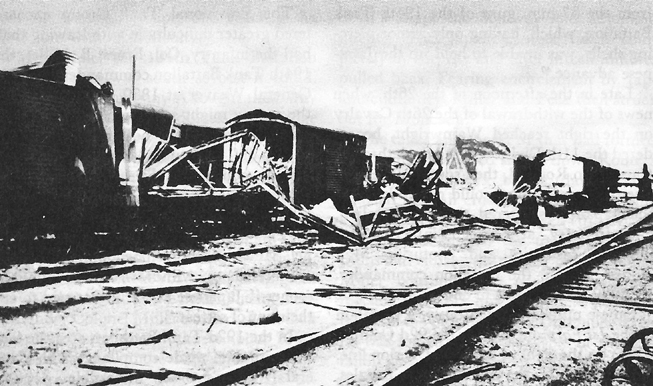 THAILAND Royal Netherlands Navy submarine HNLMS O 16 enters the shallow harbor at Mueang Patani, Thailand, where Japanese are unloading troops and equipment to move into Malaya. O.16 badly damaged 4 Japanese freighters with 6 torpedoes and then escapes, although the ships will be raised and returned to service. UNITED STATES So far, the U.S. Department of Justice has rounded up 831 enemy aliens in on the West coast, including 585 Japanese and 187 Germans. Congress, to meet the demand for trained enlisted men, authorizes the retention of enlisted men in the Navy upon the expiration of their enlistments when not voluntarily extended.
|
|
lordroel
Administrator
Posts: 68,093 
Likes: 49,488
|
Post by lordroel on Dec 14, 2020 3:48:15 GMT
Day 836 of World War II, December 14th 1941Eastern FrontFranz Halder and Günther von Kluge gave permission for a limited withdrawal for troops of the Army Group Center (Armeegruppe Mitte) in the Moscow area to the west of the Oka river, without Hitler's approval. Photo: Soldiers in camouflage cloaks on the forest's edge in the Moscow region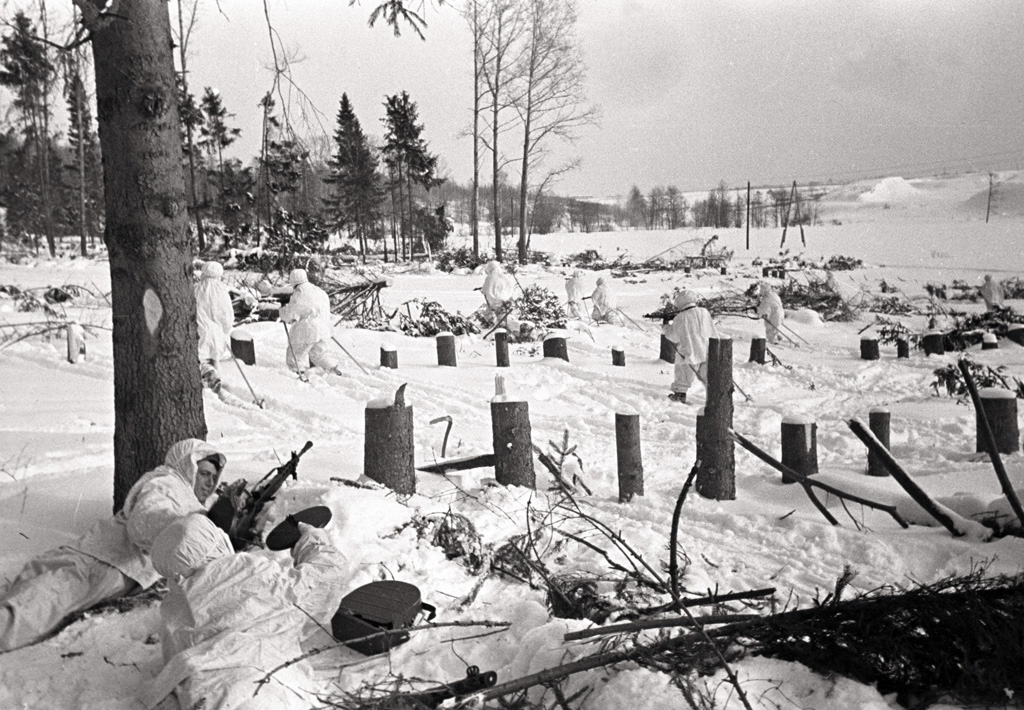 Continuation War Continuation War The Soviet 114th Division attacks in the Svir sectorin Finland and takes the village of Gora. Battles continue for nearly a month. Battle of the MediterraneanItalian battleship Vittorio Veneto, which left Naples yesterday to engage British ships after Battle of Cape Bon, is promptly torpedoed by British submarine HMS Urge in the Strait of Messina, Sicily. Vittorio Veneto is seriously damaged by a torpedo hit to the magazine (out of service for several months) but steams to Taranto escorted by 4 destroyers and 2 torpedo boats. After searching for Italian supply convoys, British cruiser HMS Galatea is returning to base at Alexandria, Egypt. After entering a mine-swept channel, the destroyer screen is sent forward to Alexandria but HMS Galatea is attacked by Italian submarine Dagabur at 7.55 PM and then again by U-557 just before midnight, causing HMS Galatea to sink within 3 minutes 35 miles West of Alexandria (470 killed, 154 survivors picked up by destroyers HMS Griffin and HMS Hotspur). Photo: HMS Galatea pictured here in April 1937 Western Desert Campaign - Operation Crusader Western Desert Campaign - Operation CrusaderBritish 4th Armored Brigade begins a long trek South to the desert crossroads at Bir Halegh el Eleba, 30 miles West of Gazala, to outflank Afrika Korps and cut off their lines of retreat along the coast or through the desert. Pacific War AUSTRALIA The Australian "Gull Force" departs Darwin, Northern Territory, for Ambon Island in the Netherlands East Indies. The force consists of 2/21st Battalion of the 23d Brigade, "C" Troop of the 18th Antitank battery and supporting troops. The troops are in two Dutch ship escorted by the Australian light cruiser HMAS Adelaide D 47) and minesweeper HMAS Ballarat (J 184). JAPAN Imperial General Headquarters orders Japanese Navy submarines to shell the U.S. West Coast. Vice Admiral SHIMIZU Mitsumi, commander of the Advance Expeditionary Force (Sixth Fleet), issues a detailed order on the targets. The submarines I-15, -9, -10, -17, -19, -21, -23, -25 and -26 are each to fire 30 rounds on the night of 25 December. Rear Admiral SATO Tsutomu, aboard the I-9, is charged to execute the order. MALAYA Japanese forces land on Penang Isaland. Penang's military importance lay in the island's port facilities and its stocks of ammunition and stores. When the Allies were unable to stop the Japanese advance on the mainland it became clear that the island would have to be evacuated. On the west coast, the Indian 11th Division completes their withdrawal to Gurun; the Japanese, in close pursuit, penetrate the new positions, during the night of 14/15 December. The Krohcol force is dissolved and its components, which are put under command of the Indian 12th Brigade, move to the Baling area, about 9 miles W of Kroh. The Indian III Corps sends small detachments to guard the Grik road, which is now uncovered. On the east coast, the Kelantan force continues fighting withdrawal. Since airdromes on Singapore Island are becoming congested, preparations are being made to base air units in the Netherlands East Indies. HAWAIIAN ISLANDS Norwegian motorship MS Hoegh Merchant is torpedoed and sunk by Japanese submarine I-4 about 29 miles off Cape Makapuu on the southeastern tip of Oahu Island. All hands (35- man crew, 5 passengers) survive the loss of the ship. Vice Admiral Wilson Brown Jr. Task Force 11 comprising the aircraft carrier USS Lexington (CV-2), three heavy cruisers, nine destroyers, and oiler USS Neosho (AO-23), sails to raid Japanese forces in Jaluit Atoll in the Marshall Island to relieve pressure on Wake Island. Admiral Frank Fletcher's Task Force 14 (TF–14) tasked with the relief of Wake Island leaves Pearl Harbor consisted of the fleet carrier USS Saratoga, the fleet oiler Neches, the seaplane tender Tangier, three heavy cruisers (Astoria, Minneapolis, and San Francisco) and 8 destroyers (Selfridge, Mugford, Jarvis, Patterson, Ralph Talbot, Henley, Blue, and Helm). The convoy carried the 4th Marine Defense Battalion (Battery F, with four 3-inch AA guns, and Battery B, with two 5-inch/51 guns) and fighter squadron VMF-221, equipped with Brewster F2A-3 Buffalo fighters, along with three complete sets of FC equipment for the 3-inch AA batteries already on the island, plus tools and spares; spare parts for the 5-inch coast defense guns and replacement fire control gear; 9,000 5-inch rounds, 12,000 3-inch (76 mm) rounds, and 3,000,000 .50-inch (12.7 mm) rounds; machine gun teams and service and support elements of the 4th Defense Battalion; VMF-221 Detachment (the planes were embarked on Saratoga); as well as an SCR-270 air search radar and an SCR-268 fire control radar for the 3-inch guns, and a large amount of ammunition for mortars and other battalion small arms. U.S. Coast Guard buoy tender USCGC Kukui reaches Niihau Island with squad of soldiers from Company M, 299th Infantry Regiment. The detachment learns of the events that have transpired on Niihau since Japanese Naval Aviation Pilot First Class NISHIKAICHI Shigenori crashed there on 7 December. Photo: Remains of NISHIKAICHI'S Zero COSTA RICA USN gunboat USS Erie (PG-50), off the Pacific coast of Costa Rica, boards and takes charge of motor vessel MV Sea Boy, and takes off a Japanese POW; she orders Sea Boy into Balboa, Canal Zone, the following day. PHILIPPINE ISLANDS The Japanese Vigan and Aparri detachments are placed under the same command and ordered, after the Aparri force joins the Vigan at Vigan, to march south to Lingayen Gulf. The USN withdraws the few remaining PBY Catalinas of Patrol Wing Ten (PatWing 10) and the three tenders servicing the aircraft from the Philippine Islands. The ships are the seaplane tenders (destroyer) USS Childs (AVD-1) and William B. Preston (AVD-7) and the small seaplane tender USS Heron (AVP-2). Patrol Wing 10 has been reassigned to the NEI. Far East Air Force B-17 Flying Fortresses are sent against the Japanese beachhead at Legaspi, Luzon, and damage a freighter and a tanker. First Lieutenant Hewitt T Wheless is later awarded the Distinguished Service Cross (DSC) for bringing his bullet-riddled B-17 back from the mission to an emergency crashlanding at Cagayan, Mindanao Island. A USN boarding party transported in commandeered yacht Gem, seizes the 14,242 ton French motor mail vessel SS Marechal Joffre, in Manila Bay. The majority of the crewmen, pro-Vichy or unwilling to serve under the U.S. flag, are transported ashore. The ship, manned by a scratch crew that includes aviation personnel from Patrol Wing Ten (PatWing 10), departs Manila Bay on 18 December bound for Balikpapan, Dutch Borneo, whence she proceeded to Australia, New Zealand, and the U.S. She arrives in San Francisco, California, with a cargo of wool and zircon sand on 19 April 1942. The following day, she is taken over by the U.S. Maritime Commission and transferred to the USN. She as commissioned on 27 April 1942 as transport USS Rochambeau (AP-63). WAKE ISLAND Two raids by Japanese naval aircraft are flown by aircraft based in the Marshall Islands. Early in the morning, "Mavis" flying boats bomb the island. At 1100 hours, 30 "Nell" bombers arrive from Roi Island in Kwajalein Atoll. They kill two marines and wound another but more seriously, they destroy one of the two remaining F4F-3 Wildcats.
|
|
lordroel
Administrator
Posts: 68,093 
Likes: 49,488
|
Post by lordroel on Dec 15, 2020 3:46:47 GMT
Day 837 of World War II, December 15th 1941Eastern FrontNorth of Moscow, Soviet tanks cut the road West of Klin isolating 1st, 2nd, 6th, 7th Panzer and 14th Motorised Infantry Divisions (3rd Panzer Army). German troops take the only route out, cross-country to the Southwest, to avoid encirclement but leave most of their equipment. Klin is abandoned at 9.30 PM. Photo: Soviet cavalry entering a Russian town, 15 Dec 1941 Battle of the Mediterranean Battle of the MediterraneanGerman submarine 'U-127' is sunk about 170 nautical miles (315 kilometers) west-northwest of the Tangier Zone in position 36.28N, 09.12W, by depth charges from the Australian destroyer HMAS 'Nestor' (G 02) which is escorting the 32 ships in convoy HG-76 (Gibraltar to the U.K.); all 51 crewmen are lost. A British supply convoy bound for Malta leaves Alexandria. EgyptThe Government in Egypt breaks diplomatic relations with Hungary and Romania. Western Desert Campaign - Operation CrusaderThe fighting on the Gazala line intensifies. The Polish Independent Brigade joins the 5th New Zealand Infantry Brigade and attacks into a small wedge the New Zealanders have driven into the line. The defending Italian Brescia and Pavia division, along with the Trento Division nearby, repel the attack. At the center of the line, the Italian Trieste Division also stands firm. The Italian divisions recover Point 204, taken by the New Zealand brigade on the 14th, and plan a further attack toward Alem Hamza. While the Axis has held the line, it also has taken huge losses. The German 15th Panzer Division, which is down to 8 tanks, moves to the rear after line stabilizes for the first time. After dark, the Afrika Korps commander General Crüwell reviews the attrition in his units and a dangerous advance by British 4th Armored Brigade to Bir Haleigh el Eleba about 30 miles (48 km) from Alem Hamza and realizes he cannot hold the line for long despite the day's successes. Crüwell reluctantly orders a retreat from the Gazala line over the bitter objections of the victorious Italian units. The move west by 15th Panzer Division is just in time to block the British tanks hoping to encircle the Gazala line and give the troops there time to escape. Photo: Upload of Polish Independent Carpathian Rifle Brigade in Alexandria for its trip to Tobruk
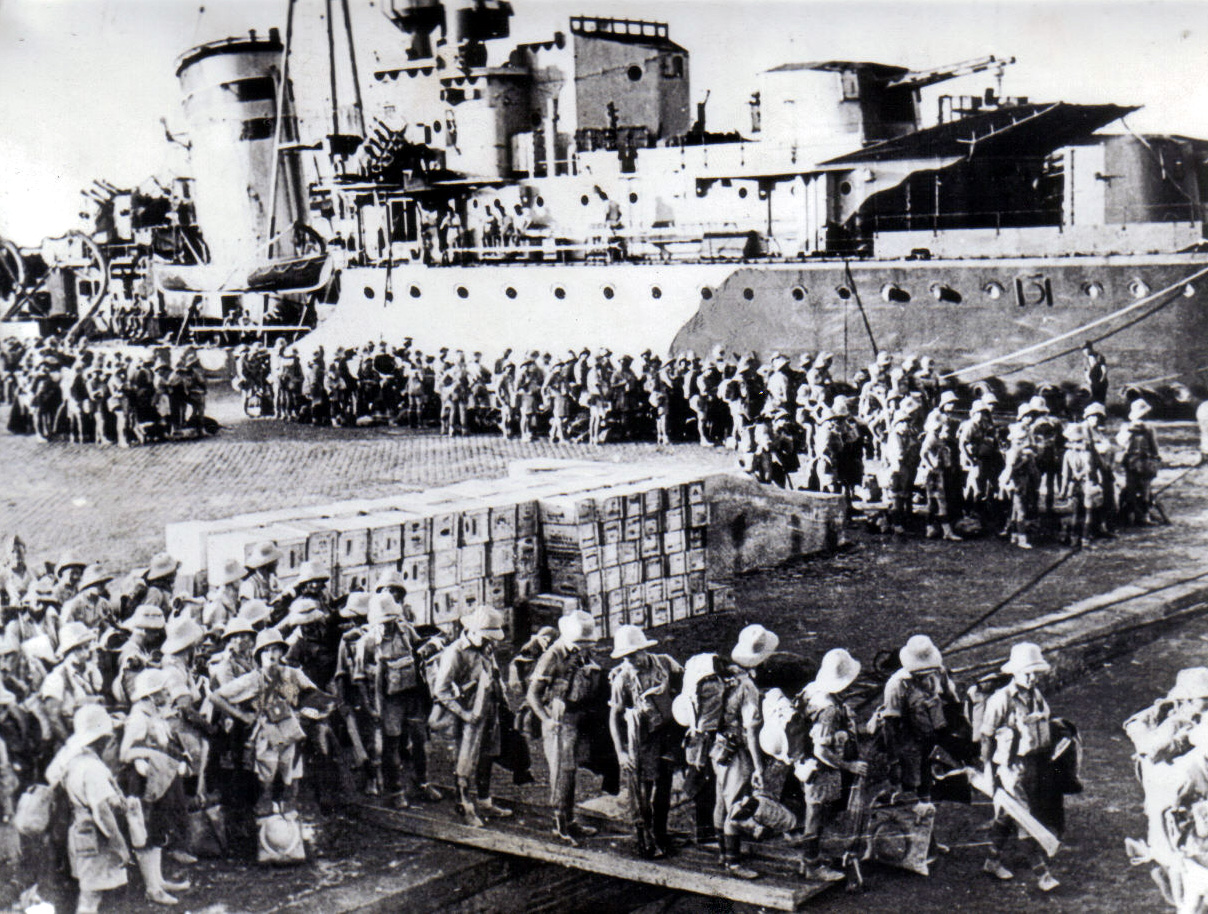 Canada Canada In Ottawa, Ontario, the Cabinet War Committee discusses financial aid to Britain; "the billion dollar gift." Pacific War HAWAIIAN ISLANDS USN seaplane tender USS Tangier, oiler USS Neches, and four destroyers sail for Wake Island. Kahului on northern Maui Island, is shelled by a Japanese submarine from the Second Submarine Squadron. Possible candidates for having carried out the shelling are I-2, I-3, I-4, I-5, I-6, or I-7. HONG KONG A Japanese attempt to move from Kowloon to Hong Kong Island is defeated. JOHNSTON ATOLL Japanese submarine I-122 surfaces and shells this U.S. possession causing slight damage to a few buildings and no casualties. One shell lands astern and another passes over her forecastle of USN transport USS William Ward Burrows (AP-6) but apparently she is unseen by the Japanese and she is not hit. The atoll consists of two small islets, Johnston and Sand Islands, located about 712 nautical miles (1319 kilometers) west-southwest of Pearl Harbor, Territory of Hawaii. MALAYA The Indian III Corps remains under strong pressure on the west coast. During the night of 15/16 December, the Indian 11th Division begins a withdrawal from the Gurun positions to the Muda River. The garrison of Penang Island. fortress, opposite RAF Butterworth, prepares to withdraw as the RAF abandons Butterworth airdrome. At 2.30 AM, submarine HNLMS O 16 sinks on a Japanese mine 22 miles Northeast of Tioman Island, Malaya (41 killed, 1 survivor Boatswain Cornelis de Wolf swims ashore 44 miles South on Aur Island after 35 hours in the water). Photo: submarine O 16 late 30's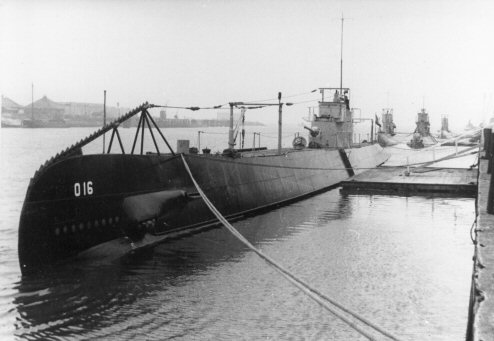 PHILIPPINE ISLANDS Major General Lewis H Brereton, Commanding General Far East Air Force, receives permission to withdraw the few remaining B-17 Flying Fortresses to Bachelor Field, Darwin, Northern Territory, Australia. The air defense of the Philippines is left to the few remaining fighters. PT-33, damaged by grounding and sunk by United States forces, Philippine Islands area, 13 d. 46' N., 120 d. 40' E. UNITED STATES The Congress passes a military appropriation bill of US$10 billion (US$132.9 billion in year 2020 dollars) for the defense of the country. After a brief visit to Hawaii, Secretary of the Navy Frank Knox tells the press, "I think the most effective Fifth Column work of the entire war was done in Hawaii with the possible exception of Norway" -this despite the complete lack of evidence of such sabotage. Norman Corwin's production of "We Hold These Truths," commissioned by President Franklin D. Roosevelt and starring Orson Welles, is broadcast simultaneously on all four national US radio networks CBS, Mutual and NBC's Red and Blue Networks. It reaches an estimated audience of 63 million people, the largest ever for a dramatic production of any kind. Admiral Ernest J. King is offered the post of Commander in Chief U.S. Fleet. He accepts. An American Federation of Labor (AFL) council adopts a no-strike policy in war industries, which include automotive plants being converted to military production (domestic automobile manufacturing stopped completely from 1941 to 1944). WAKE ISLAND Early in the morning, "Mavis" flying boats bomb the island.
|
|
lordroel
Administrator
Posts: 68,093 
Likes: 49,488
|
Post by lordroel on Dec 16, 2020 3:49:21 GMT
Day 838 of World War II, December 16th 1941Eastern FrontIn the quadrant North to West of Moscow, Red Army has pushed 3 German Armies back 50 miles after 12 days of fighting. Germans are in full retreat, demoralized and facing temperatures as low as −42°F (also −42°C). Soviet forces recapture Kalinin from German 9th Army. Photo: Heavy gun crew firing at enemy positions during the Great Patriotic War Air War over Europe Air War over Europe Overnight, RAF drops 100 tons of high explosive bombs and 14,000 incendiary canisters on Mannheim, Germany, in retaliation for the firebombing of Coventry on November 14. 8 pathfinder bombers miss the city center with incendiary canisters, causing most of the other bombers to miss the target (34 civilians killed, 81 injured). Learning from this failure, RAF develops the concept of "bomber stream" to drop the maximum amount of bombs in the smallest area over the shortest time. Battle of the MediterraneanAt 9.44 PM 18 miles West of Crete, Italian torpedo boat Orione rams and sinks U-557, mistaking it for a British submarine (all 43 hands lost). Orione is damaged and returns to Suda Bay, Crete. At 7.50 PM off Cape Juby, Morocco, U-37 stops wooden Spanish steamer San Carlos with 1 torpedo and then tries to sink her with 21 rounds from the deck gun (1 killed). German sailors, rowing over to place scuttling charges, notice that the shells did not penetrate the wooden hull. 15 crew and 13 passengers abandon ship in 2 lifeboats. British submarine HMS Truant sinks Italian tanker Bonzo in the Ionian Sea 2 miles off the coast of Calabria in the toe of Italy. Western Desert Campaign - Operation CrusaderBritish 4th Armoured Brigade captures the Italian camp at Sidi Omar, which was leapfrogged in the rush into Libya to surround Bardia. They attack from the South and West, while the Italian artillery is facing East. The battle lasts 10 minutes (50 Italians killed, 900 taken prisoner). Pacific WarBURMA Invasion of Burma begins. Japanese infantry (who infiltrated across the border from Thailand on December 12th) capture Victoria Point on the Southern tip of Burma, from a platoon of the Burma Frontier Force. MALAYA British and Europeans evacuate Penang Island for the safety of Singapore, leaving behind the local inhabitants. Demolition parties destroy artillery and anti-aircraft guns, ammunition and supplies but the radio station is left intact and will be used for Japanese propaganda. Many ships in the harbor are not scuttled and will be used by the Japanese to outflank British defenses on the West coast by sea. BORNEO 10 Japanese troop transports left Cam Ranh Bay, French Indo-China, 2 days ago, escorted by 3 cruisers and 6 destroyers. At 5 AM, Japanese troops come ashore at British protectorates on the North shore of Borneo meeting minimal resistance. They quickly capture oilfields at Miri & Seria and the refinery at Lutong, beginning to execute the major Japanese war aim of securing oil supplies. PHILIPPINE ISLANDS 1st Lieutenant Boyd D. Wagner of the 17th Pursuit Squadron (Interceptor), 24th Pursuit Group (Interceptor), leads a dive-bombing raid on the airfield at Vigan and shoots down his fifth aircraft, thereby becoming the first Army Air Forces "Ace" in World War II. HONG KONG Japanese troops force landings on Hong Kong island.
|
|
lordroel
Administrator
Posts: 68,093 
Likes: 49,488
|
Post by lordroel on Dec 17, 2020 3:49:01 GMT
Day 839 of World War II, December 17th 1941Eastern FrontIn the Crimea, German attacks by the 54.Korps of the German Heeresgruppe Sud begin against the city of Sevastopol despite continuing Soviet offensives in other areas. Hitler begins to purge the Generals he feels have failed him in Russia. After the failure of Operation Typhoon to capture Moscow, Hitler relieves von Bock from command of Army Group Center, officially citing “health problems”. The Soviet submarine 'M-59' is sunk by depth charge by Romanian destroyer 'Ferdinand' in the Black Sea. Photo: Fresh Soviet forces going to the front from Moscow Battle of the Atlantic Battle of the Atlantic German submarine 'U-131' is sunk about 191 nautical miles (353 kilometers) east-northeast of the Madeira Islands in position 34.12N, 13.35W, by depth charges and gunfire from the British destroyers HMS 'Exmoor' (L 08 ), 'Blankney' (L 30) and 'Stanley' (I 73), the corvette HMS 'Pentstemon' (K 61) and the sloop HMS 'Stork' (L 81), and by depth charges from a British (F4F) Martlet of No. 802 Squadron in the escort carrier HMS 'Audacity' (D 10) all of which are escorting the convoy HG76 (Gibraltar to the U.K.); all 47 U-boat crewmen are lost. HMS 'Stanley' is the former USN destroyer USS 'McCalla' (DD-253) which was commissioned as HMS 'Stanley' (I-73) on 23 October 1940, as part of the destroyers-for-bases deal. Battle of the MediterraneanU-67, U-107, U-108, U-131 & U-434 stalk a convoy (HG-76) returning from Gibraltar to Britain. At 9.25 AM 230 miles Northeast of Madeira, a Martlet aircraft from escort carrier HMS Audacity spots U-131 shadowing HG-76. British destroyers HMS Stanley, HMS Exmoor and HMS Blankney, corvette HMS Pentstemon and sloop HMS Stork, attack with depth charges. Yesterday, a large Italian convoy left Naples, Italy, and by the time it had reached Sicily, it was escorted by the battleship R.N. 'Caio Duilio', the light cruisers R.N. 'Emanuele Filiberto Duca'd'Aosta', 'Raimondo Montecuccoli' and 'Muzio Attendolo' and a few destroyers. Not too far away, a second group, composed of the battleships R.N. 'Littorio', 'Andrea Doria' and 'Giulio Cesare', the heavy cruisers R.N. 'Trento' and 'Gorizia' and several destroyers, provided additional support. Such a display of force is unnecessarily caused by the mistaken spotting of two British battleships in Malta. Today, a Luftwaffe reconnaissance plane spots a British formation proceeding from Alexandria, Egypt, toward the central Mediterranean. A battleship, identified as part of the group, is actually a tanker, but the faulty identification is repeated several times. During the day British naval Force K, composed of the light cruisers HMS 'Neptune' (20), 'Aurora' (12), 'Penelope' (97) and destroyers HMS 'Kandahar' (F 28 ), 'Lance' (G 87), 'Lively' (G 40) and 'Havock' (H 43), joins Admiral Vian's Force B from Alexandria. Tonight this British force meets the Italian convoy escort. The action, the First Battle of Sirte, is spent protecting the convoy and is therefore indecisive. Both navies are simply escorting their convoys, but each thinks of the other as in pursuit of a naval engagement. The British are actually trying a double convoy attempt, one eastbound and one westbound. While the British commander Admiral Cunningham orders the convoy commander Admiral Sir Philip Vian to avoid direct contact, Italian Admiral Angelo Iachino was in active pursuit of a direct confrontation. The distance between the two groups, and some British avoidance maneuvers, did not allow the battleship R.N. 'Littorio' group to sight the British until almost dusk. The sighting is aided by the antiaircraft guns of the British forces which are actively trying to repulse an Axis aerial attack. The 'Littorio' opens fire at about 32 kilometers (17.3 nautical miles) from the British force; too far a distance for the British unit to reply. Admiral Vian immediately attempts a retreating maneuver with the aid of a smoke screen. British units receive some direct hits, but they were able to disappear into the darkness of the night. The British ships run into a newly-laid Italian minefield; the light cruiser HMS 'Neptune' (20) hits four mines and is sunk and there is only one survivor from a crew of 767 and the destroyer HMS 'Kandahar is sunk but all of her crew are taken off first. The light cruiser HMS Aurora is badly damaged and destroyer HMS 'Penelope' is slightly damaged. United States At a press conference in Washington, President Roosevelt outlines a scheme for USA to provide munitions and equipment to Britain without requiring payment. It will become known as “Lend-Lease”. United Kingdom Major General James E Chaney, Chief Special Observer Group, U.S. Army (SPOBS), writes to the Adjutant General, U.S. Army on the "Construction Program of U.S. Forces in UK," which indicates a shortage of accommodations for proposed U.S. forces in England, Northern Ireland and Scotland. Pacific War AUSTRALIA USAAF Far East Air Force B-17 Flying Fortresses, evacuating Luzon, Philippine Islands, begin arriving at Batchelor Field near Darwin, Northern Territory. A plan is drawn up for using Australia as an Allied supply base under command of Major General George H. Brett, USA. NETHERLANDS EAST INDIES The Australian "Gull Force" lands on Ambon Island, Netherlands East Indies. This force is comprised of the 2/21st Battalion of the 23rd Brigade, "C" Troop of the 18th Antitank Battery, a section of 2/11th Field Company and various other support units. The force had been transported from Darwin, Northern Territory, Australia, to Ambon in three Dutch merchant ships escorted by an Australian light cruiser and corvette. WAKE ISLANDS At 8.20 PM 25 miles Southwest of Wake Island, Japanese submarines RO-62 and RO-66 simultaneously surface to charge their batteries. In a heavy squall, RO-62 rams and sinks RO-66 (63 killed, 3 lookouts thrown overboard by the collision picked up by RO-62) HAWAIIAN ISLANDS In a command shakeup, Admiral Husband E. Kimmel is replaced by Admiral Chester W. Nimitz as Commander-in- Chief, Pacific Fleet; Lieutenant General Walter C. Short, Commanding General Hawaiian Department is replaced by Lieutenant General Delos C. Emmons; and Major General Frederick L. Martin is replaced by Brigadier General Clarence L Tinker as Commanding General, Hawaiian Air Force. A Japanese "Glen" seaplane (Yokosuka E14Y1, Navy Type 0 Small Reconnaissance Seaplane) makes its operational debut when the submarine I-7 launches the aircraft for a dawn reconnaissance over Pearl Harbor to determine the damage caused by the attack of 7 December. HONG KONG The Japanese control the north side of Hong Kong Harbor, the British Hong Kong Island. After a week of air bombardment, Japanese Lieutenant General SANO Tadayoshi, commanding the 38th Division, sends a captured British civilian woman (and her two dogs) across the harbor to demand surrender from British Governor Sir Mark Young. Sir Mark himself "declines absolutely to enter into negotiations for the surrender of Hong Kong." MALAYA Hard fighting continues on the Grik road. A weak defense detachment is reinforced but falls back under pressure of the superior Japanese forces. The Indian 12th Brigade Group is ordered to Kuala Kangsar. British Lieutenant General Sir Arthur E. Percival, General Officer Commanding Malaya Command, gives the Indian III Corps permission to withdraw to the Perak River line if necessary. The Perak Flotilla is formed to prevent the Japanese from landing on the west coast between Knan and Bernam Rivers. MIDWAY ISLANDS Seventeen SB2U-3 Vindicators of Marine Scout Bombing Squadron Two Hundred Thirty One complete a record 9 hour and 45 minute flight from Hawaii to Midway, bolstering U.S. positions there. The aircraft were led by a plane-guarding PBY-4 Catalina of Patrol Squadron Twenty One (no ships are available to plane-guard the flight) on this longest over-water massed flight (1,137 miles or 1 830 kilometers) by single-engine aircraft. VMSB-231 was the same squadron that was en route to Midway on 7 December aboard the aircraft carrier USS Lexington (CV-2) when reports of the attack on Pearl Harbor forced the carrier to turn back short of her goal. PACIFIC OCEAN Japanese submarine I-15 surfaces to charge batteries near the Farallon Islands about 29 nautical miles west of San Francisco, California. Seeing the lights of the city, Captain IMAZATO Hiroshi jokes to the crew that it was a good time to visit the famous city of San Francisco. Japanese submarine I-175 torpedoes and sinks a 3,283 ton unarmed U.S. freighter about 222 nautical miles SSE of Honolulu, Territory of Hawaii. The survivors are rescued on 27 and 28 December. In the South China Sea, the Japanese destroyer Shinonome, part of a convoy of troop transports, heading towards the Malayan Peninsula, is sunk near Seria, 20 miles (32 kilometers) west of Miri, Sarawak,by two bombs from a Dutch three engine Dornier Do-24K flying boat of the Dutch Naval Air Group based on the island of Tarakan. The crew of the Dornier drop three bombs, two making direct hits, the third a near miss. The destroyer blows apart in an enormous explosion causing fires to break out on the vessel. It takes only a few minutes for the destroyer to roll over and sink. There are no survivors; all 229 crewmen are lost. PHILIPPINE ISLANDS The Japanese Legaspi force, advancing northwest on Luzon along Route 1 toward Naga, makes its first contact with Filipino forces near Ragay.
|
|
lordroel
Administrator
Posts: 68,093 
Likes: 49,488
|
Post by lordroel on Dec 18, 2020 7:43:35 GMT
Day 840 of World War II, December 18th 1941East FrontRed Army fails to keep contact with the retreating German forces Northwest to West of Moscow, allowing 3rd Panzer Army to fall back over the Lama River while 4th Panzer Army gets behind the Ruza River. Although the rivers are frozen, Soviet troops will fail to cross and allow the Germans to dig in and establishes defensive positions. Photo: A Red Army scouting unit comprising motorcyclists and armored cars enroute to the front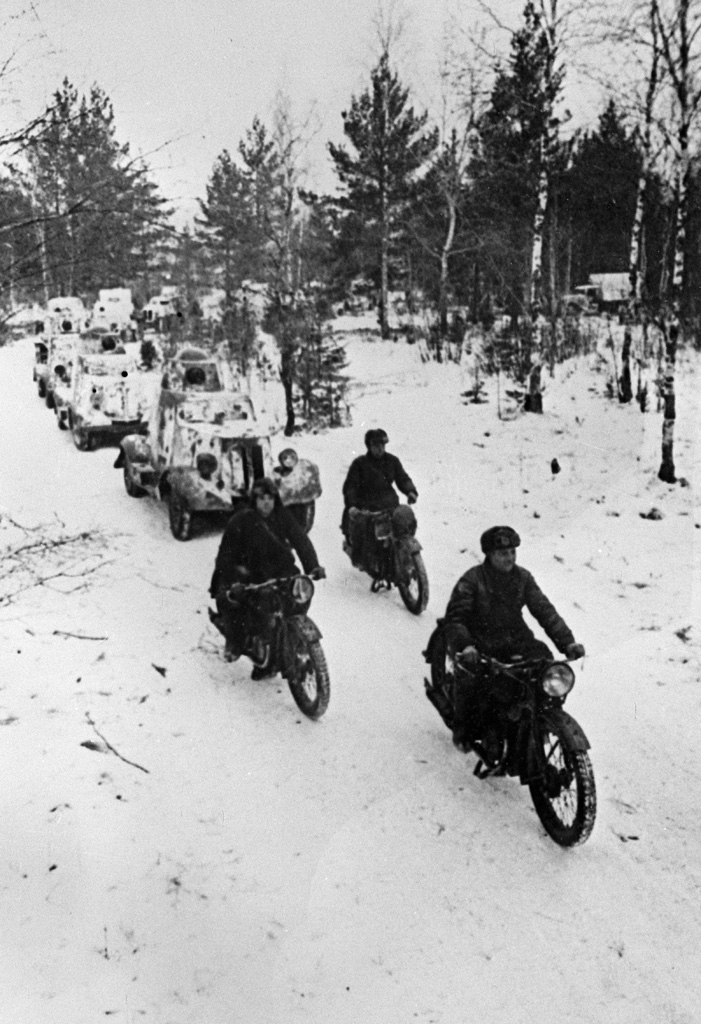 Air War over Europe Air War over Europe During the day, RAF Bomber Command aircraft bomb Brest and the crews reported that, at long last, the German battleship 'Gneisenau', still harbored in the port, is hit during an attack by 47 aircraft. Battle of the Atlantic Battle of convoy HG-76. At 9.45 AM 560 miles West of Gibraltar, British destroyers HMS Stanley and HMS Blankney bring U-434 to the surface with depth charges. U-434 crew places scuttling charges and abandons ship (42 survivors taken prisoner by HMS Blankney, 2 killed in Blankney‘s propellers during maneuvering). U-434 explodes and sinks before HMS Blankney can get a boarding party aboard. The first German submarine involved in Unternehmen DRUMBEAT (Paukenschlag) , 'U-125', sails from Lorient. Unternehmen DRUMBEAT is an attack on shipping along the North American coast by five U-boats. Western Desert Campaign - Operation CrusaderRommel has so few tanks operational (Afrika Korps has 8, Italian Ariete Division has 30) that he decides to retreat all the way to strong defensive position at Mersa Brega, whence he launched his attack in April. The infantry will follow the coastal road while the tanks will cut across the desert South of the Green Mountain (Jebel Achdar). British 4th Armored Brigade is slow to get going from Bir Halegh el Eleba, (wary of previous maulings by Rommel's anti-tank guns when they chased the Afrika Korps) and reaches Mechili, 25 miles West, too late to catch the retreating tanks. Operation Crusader has achieved the objectives of pushing Rommel back out of Eastern Libya and relieving the siege of Tobruk but, in doing so, the British have used up all their reserves of tanks. Rommel's Afrika Korps has survived, barely, and will soon receive fresh supplies of tanks. Photo: Damaged Panzer IIIs at Belhamed United States United States Censorship is imposed with the passage of the first American War Powers Act. This act is passed by Congress, authorizing the president to initiate and terminate defense contracts, reconfigure government agencies for wartime priorities, and regulate the freezing of foreign assets. It also permits him to censor all communications coming in and leaving the country. President Franklin D. Roosevelt appoints the executive news director of the Associated Press, Byron Price, as director of censorship. Although invested with the awesome power to restrict and withhold news, Price takes no extreme measures, allowing news outlets and radio stations to self-censor, which they do. Most top secret information, including the construction of the atom bomb, remains just that. The most extreme use of the censorship law seems to have been President Roosevelt signs Executive Order No. 8984 that provides that the Commander in Chief U.S. Fleet will take supreme command of the operating forces of all Navy fleets and coastal frontier commands, and be directly responsible to the President.The State Department announces that Rear Admiral Frederick J. Horne and Admiral Georges Robert, French High Commissioner at Martinique, French West Indies, have reached an agreement neutralizing French Caribbean possessions. Pacific War PACIFIC USN - Two-plane detachments from Patrol Wings 1 and 2, based in Hawaii, began scouting patrols from Johnston. CHINA Following an operational loss of an American Volunteer Group (Flying Tigers) aircraft and the ensuing confrontation between the pilot, Eriksen Shilling, and a group of Chinese, "blood chits" are developed. The first blood chits are printed on silk by Chinese Intelligence and stitched on the back of the American's flight jackets. It shows the flag and promised a reward for assisting the bearer. The message is printed in several languages. Photo: A "blood chit" issued to the American Volunteer Group Flying Tigers. The Chinese characters read: "This foreign person has come to China to help in the war effort. Soldiers and civilians, one and all, should rescue and protect him"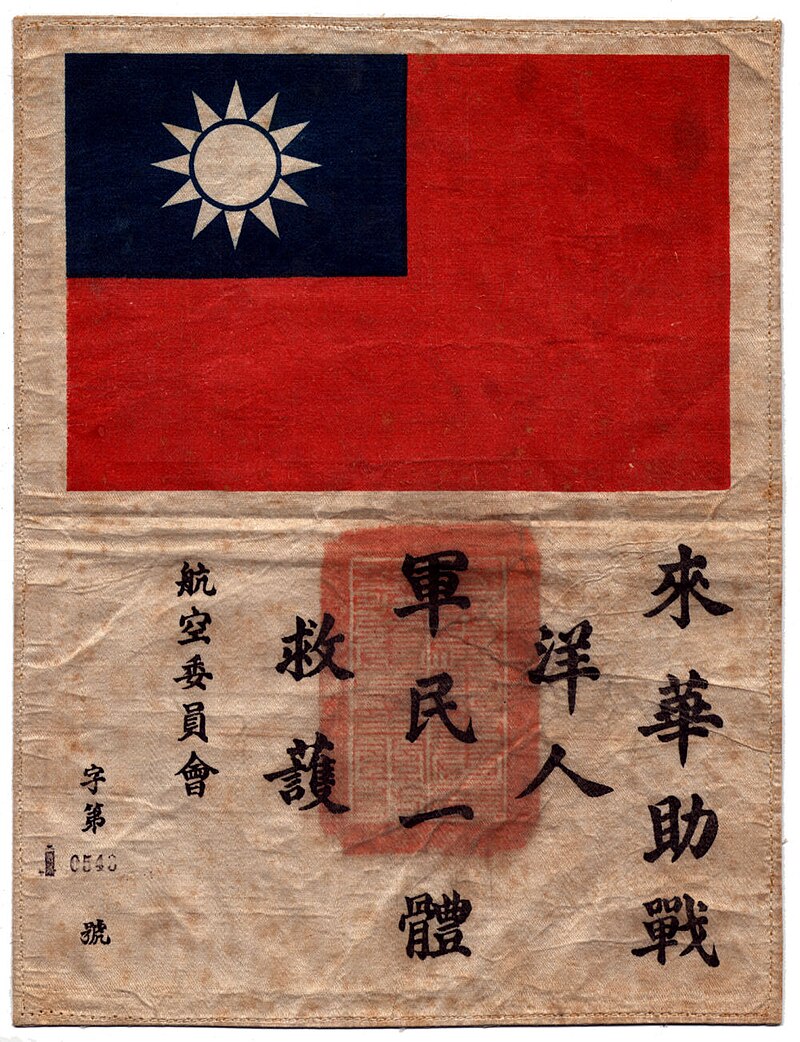 HONG KONG During the night of 18/19 December, the Japanese land troops on Hong Kong Island between North Point and the Lei U Mun Channel. The landings are successful despite counterattacks by the undermanned British and Canadian Royal Rifles of against Japanese positions on Sai Wan Hill and Mount Butler. The first wave of Japanese troops land in Hong Kong with artillery fire for cover and the following order from their commander, Lieutenant General SAKAI Takashi, Commander of the 23rd Army, "Take no prisoners." After overrunning a battery of anti-tank guns manned by local volunteers. The Japanese rope together all 20 survivors of the action, and bayonet them to death. The Japanese then storm a Royal Army Medical Corps (RAMC) dressing station, which offers no resistance. The Japanese shoot and bayonet to death eight Canadians, four Royal Army Medical Corps soldiers, and three St. John's Ambulance men. Photo: Japanese 10th Independent Artillery Brigade attacking North Point Power Station, Hong Kong After seizing the Lei Yu Mun Channel, the Japanese 38th Division storms across Hong Kong Island from east to west, splitting the two British defending brigades. The Japanese quickly take control of key reservoirs, threatening the British and Chinese inhabitants with a slow death by thirst. Map: Colour map of the Japanese invasion of Hong Kong, December 1941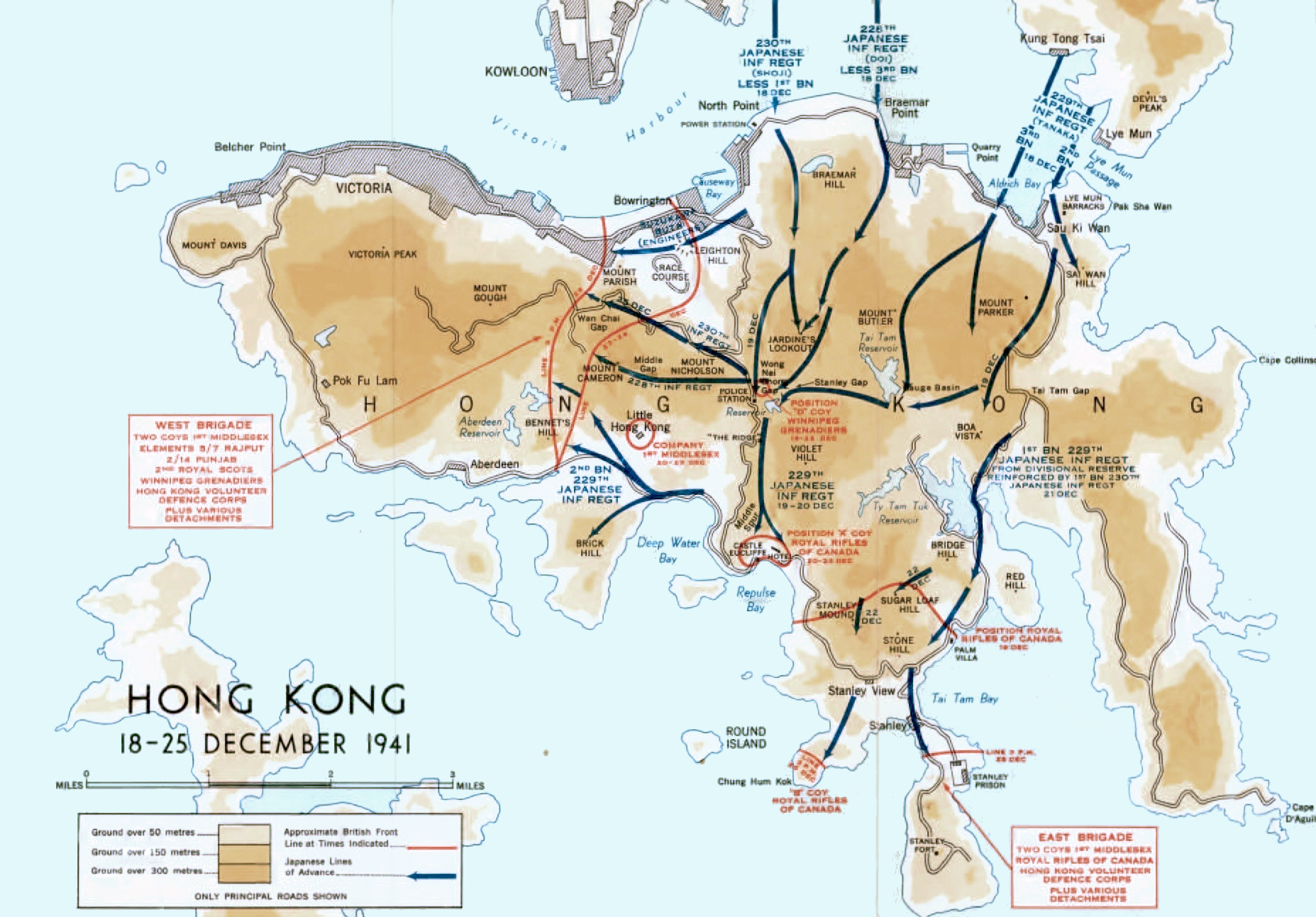 MALAYA The Indian 11th Division completes their withdrawal behind the Krian River and is held in reserve in the Taiping area. Forces defending the Grik road are further reinforced. After visiting forward areas, Lieutenant General Sir Arthur E. Percival draws up plans for a withdrawal behind the Perak River; he also decides to amalgamate certain units, among them the Indian 6th and 15th Brigades (to be designated the Indian 6/15 Brigade) and to incorporate the Indian 12th Brigade Group in the Indian 11th Division. The Japanese occupy Penang which was evacuated by the British yesterday. All combat-worthy aircraft in Malaya are ordered to fly to Singapore. Japanese naval vessel sunk: Destroyer Shinonome, by mine, Miri, Borneo. Photo: Shinonome in 1930 PHILIPPINE ISLANDS On Luzon, the Japanese Legaspi detachment reaches Naga. The French 14,000-ton motor mail vessel Marechal Joffre, manned by a scratch crew that includes aviation personnel from the USN Patrol Wing Ten, departs Manila Bay for Balikpapan, Borneo, and then to Australia, New Zealand and finally, San Francisco arriving in April 1942. Marechal Joffre will be formally acquired by the Navy and commissioned as the transport USS Rochambeau (AP-63) on 27 April 1942.
|
|
lordroel
Administrator
Posts: 68,093 
Likes: 49,488
|
Post by lordroel on Dec 19, 2020 14:33:33 GMT
Day 841 of World War II, December 19th 1941YouTube (The Japanese are unstoppable everywhere)East FrontThe Germans continue their attack on Sevastopol, while the Soviets bring 14,000 men and supplies into the area as reinforcements. Photo: Horse patrol in a street of Kryukovo village in the Moscow suburbs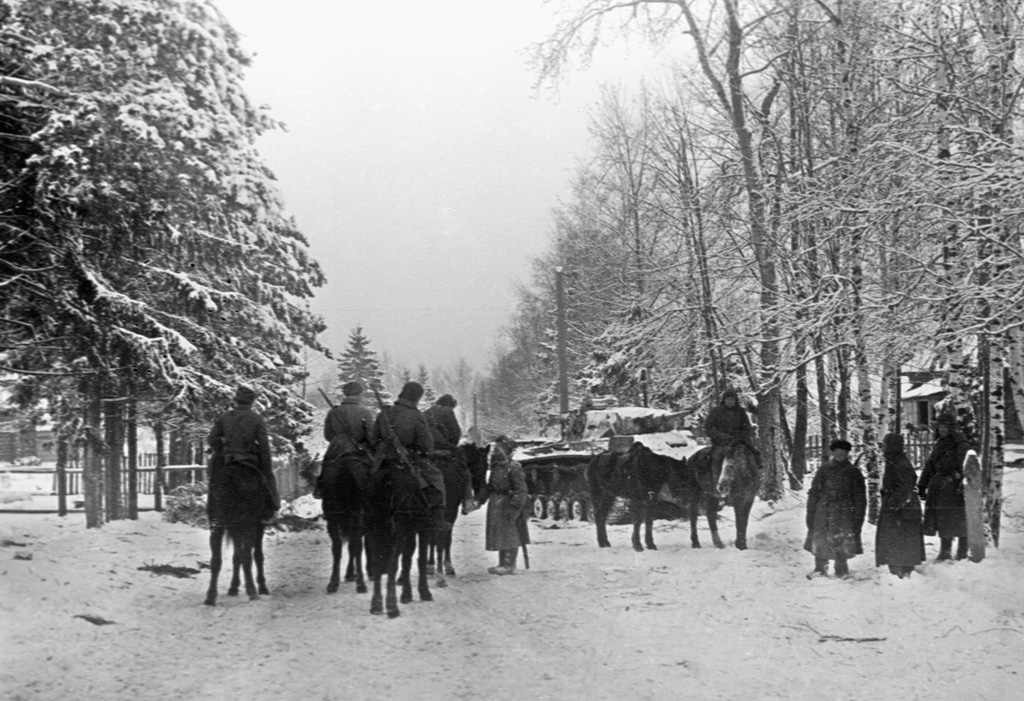 Germany Germany With the retirement of Field Marshal Walther von Brauchitsch as Commander in Chief of the Army yesterday, Chancellor Adolf Hitler himself assumes personal command of the Army, especially of its operations on the Eastern front. Initial success leads Hitler to a hypnotic belief in his ability. When the success turns, Hitler remains convinced and therefore believes that the efforts of others is at fault. Battle of the AtlanticBattle of convoy HG-76. After sinking 2 U-boats in the last 2 days, British destroyer HMS Stanley’s luck runs out when she is sunk at 4.15 AM by U-574 with 3 torpedoes, 435 miles West of Lisbon, Portugal (136 dead). British sloop HMS Stork counterattacks with depth charges, sinking U-574 by ramming 12 minutes later (28 dead, 16 survivors taken prisoner). HMS Stork and corvette HMS Samphire pick up 25 survivors from HMS Stanley. At 6.15 AM, U-108 damages British SS Ruckinge (3 dead, 39 survivors) which is shelled and sunk by HMS Samphire. Battle of the MediterraneanAt 1 AM, British cruisers HMS Neptune, Aurora & Penelope and destroyers HMS Kandahar, Lance, Lively and Havock (seeking an Italian convoy bound for Tripoli) run into a new minefield 30 miles Northeast of Tripoli. HMS Aurora & Penelope are damaged immediately. Between 1 and 4 AM, HMS Neptune hits 4 mines and sinks (766 killed, 1 survivor Leading Seaman Norman Walton found by an Italian torpedo boat on December 24). HMS Kandahar hits a mine attempting to assist (79 killed, 104 taken off) and will be scuttled next day. During the night of 18/19 December, the Italian submarine R. Smg. Scir launches three SLC (Slow Moving Torpedo) human torpedoes off the British naval base at Alexandria. The SLCs are a 21-inch (53 centimeter) torpedo fitted with an electric motor powered by batteries with an explosive charge in the detachable head. The weapon is manned by two operators using breathing apparatus. After release the SLCs, the submarine returns to La Spezia, Italy. Anticipating the return of the British Force B to Alexandria, the harbor nets are left open allowing the three SLCs to slip in and direct their weapons toward the designated targets. Since the expected aircraft carrier HMS 'Eagle' (94) is no longer in the harbor, the three attach their explosive charges to the battleships HMS 'Valiant' (02) and 'Queen Elizabeth' (00) and the large tanker SS 'Sagona'. Map: Italian map of the Decima Mas raid on Alexandria Harbor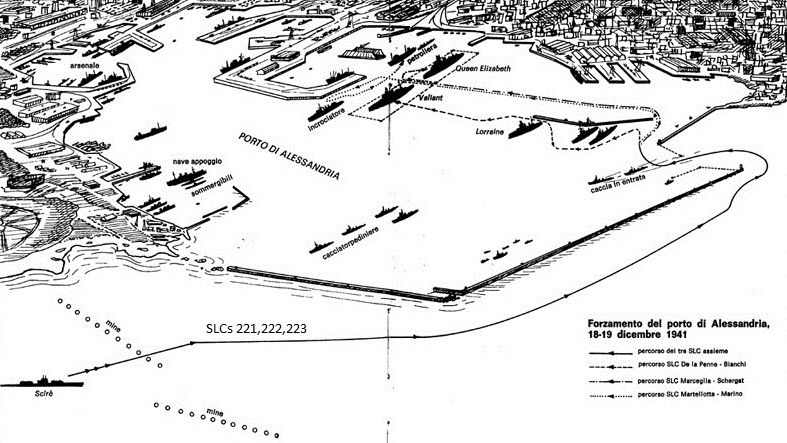 Photo: Italian submarine Scire Photo: Italian submarine Scire Two Italian frogmen are captured, Lieutenants Luigi Durand de la Penne and Bianchi. They refuse to divulge any information until moments before the explosion (because they are being interrogated right above the area of the keel where the explosion is to occur). At 0600 hours local, the first charge detonates under the tanker SS 'Sagona' and badly damages both the tanker and the destroyer HMS 'Jervis' (F 00), which is moored alongside for refueling. The charge under HMS 'Valiant' detonates at 0620 hours, and the one under HMS 'Queen Elizabeth' at 0624 hours. The depth of water is 15 to 50 feet (4,6 to 15 meters) and the charges weighed about 300 kilograms (661 pounds). Both battleships were severely damaged and remained out of the war for a period of time. The Italians are interned in a POW camp for the rest of the war. This attack, which neutralizes the ability of the British to oppose the Italian Regia Marina with its battleships, allows deeply needed convoys to supply Axis forces in Africa. Photo: HMS Queen Elizabeth in Alexandria harbor, Egypt. She is surrounded by anti-torpedo nets Western Desert Campaign - Operation Crusader Western Desert Campaign - Operation CrusaderAxis forces continue their retreat in Cyrenaica. The XIII Corps, British Eighth Army, continues to follow the withdrawing Axis forces, the Indian 4th Division advancing along the coast to Derna and the British 7th Armoured Division across the desert. Dictator Benito Mussolini requests German assistance for his hard-pressed troops in the Cyrenaica region of Libya in the form of a Panzer Division and various logistical support. United States The US Selective Service (draft) Act is amended requiring the registration of all males 18-64. The age for those subject to military service is 20-44. Lieutenant General John DeWitt, Commanding General of the Fourth Army and the Western Defense Command, recommends to the War Department to round up "all alien subjects 14 years of age or over, of enemy nations and remove them to the Zone of the Interior (ZI)," because the West Coast had become a wartime Theater of Operations. DeWitt also writes, "...that there are approximately 40,000 of such enemy aliens and it is believed that they constitute an immediate and potential menace to vital measures of defense." "all alien subjects 14 years of age or over, of enemy nations and remove them to the Zone of the Interior (ZI),"because the West Coast had become a wartime Theater of Operations. DeWitt also writes, "...that there are approximately 40,000 of such enemy aliens and it is believed that they constitute an immediate and potential menace to vital measures of defense."....Vice Admiral Randall Jacobs relieves Rear Admiral Chester W. Nimitz as Chief of the Bureau of Navigation. The U.S. Naval Academy Class of 1942 is graduated early, due to the National Emergency. Pacific War BURMA The Japanese overrun Bokpyin, a village about 100 miles N of Victoria Point. A controversy known as the Tulsa Incident, arises as a U.S. officer asks the Government of Burma to impound Lend-Lease material at Rangoon (a valuable part of which is loaded on the SS Tulsa in the harbor), pending a decision on its use. At the suggestion of the senior Chinese representative in Burma, a committee is subsequently formed to determine the division of supplies. General Claire L. Chennault and his "Flying Tigers," a group of "volunteer" pilots, set up headquarters 150 miles (241 kilometers) from Rangoon. From today until 4 July 1942, they destroy 297 Japanese planes and kill some 500 of the enemy. HAWAIIAN ISLANDS The USN's Task Force 8 (Vice Admiral William F. Halsey, Jr.), consisting of the aircraft carrier USS Enterprise, heavy cruisers, and destroyers, sails from Pearl Harbor, Oahu, proceeding to the waters west of Johnston Island and south of Midway to cover TF 11 and TF 14 operations. (TF 11 is en route to the Marshall Islands while TF 14 is en route to Wake Island). Destroyer USS Craven, in TF 8, is damaged by heavy sea soon after departure, however, and returns to Pearl for repairs. HONG KONG Japanese troops surround the headquarters of Canadian Brigadier John Lawson, Commanding Officer West Brigade, at Wong Nei Chong Gap. Lawson is killed in an attempted breakout becoming the first Canadian General killed in WWII. Canadian Sergeant Major John Robert Osborn of the 1st Battalion, Winnipeg Grenadiers, dies during an attempt to recapture Mount Butler. Osborn falls on a grenade to save others in the company and is posthumously awarded the Victoria Cross. Five British naval ships are scuttled to prevent capture by the Japanese: (1) the barrage/gate vessels HMS Aldgate and Watergate, (2) the tugs HMS Alliance and Poet Chaucer and (3) the boom defense vessel HMS Barlight. Barlight is raised by the Japanese and commissioned on 20 September 1942 as Netlayer 101. She is sunk on 15 June 1944 in Tanapag Harbor Saipan Island, Mariana Islands by USN destroyer USS Halsey Powell. MALAYA The Japanese are active against the right flank of the Krian River line; on the Grik road, the Japanese frustrate the efforts of the Indian III Corps to recover lost ground. RAF fighters based at Ipoh are forced to withdraw to Kuala Lumpur. The Indian 9th Division continues their withdrawal southward in eastern Malaya and abandons the Kuala Krai railhead. PACIFIC OCEAN Japanese submarine I-172 torpedoes and sinks a 5,113 ton unarmed U.S. freighter about 296 nautical miles SSE of Honolulu, Territory of Hawaii. Twenty five crewmen survive and are rescued. In the South China Sea, the Dutch submarine HNLMS O-20 is scuttled by her own crew, about 22 nautical miles E of Kota Bharu, Malaya, to prevent her capture by the Japanese. The sub was damaged by depth charges from two Japanese destroyers earlier in the day. PHILIPPINE ISLANDS On Luzon, the Japanese Legaspi detachment reaches Sipoco and is reported to be pushing toward Daet. At dusk, 12 Japanese fighters based on Luzon attack Del Monte Airfield on Mindanao destroying three USAAF Far East Air Force B-18 Bolos that had just arrived from Luzon with evacuees. During the night of 19/20 December, two Japanese task forces from Palau Islands, Caroline Islands, totaling about 5,000 men, arrive off Davao. The air echelon of the 93d Bombardment Squadron, 19th BG (Heavy) transfers from Clark Field to Batchelor Field with B-17's. The ground echelon is attached to the 5th Interceptor Command (Provisional) and will fight as infantry on Luzon and Mindanao Islands in the Philippines. WAKE ISLAND Japanese "Nell" bombers based on Roi Island, Kwajalein Atoll, Marshall Islands, bomb the islands, targeting installations on Wake and Peale islets.
|
|
lordroel
Administrator
Posts: 68,093 
Likes: 49,488
|
Post by lordroel on Dec 20, 2020 8:01:06 GMT
Day 842 of World War II, December 20th 1941Eastern Front Having pushed back the Panzer Armies to the North and South of Moscow, Zhukov turns his attention to the infantry in the middle (von Kluge’s 4th Army dug in behind the Nara River Southwest of Moscow). Soviet 5th, 33rd, 43rd & 49th Armies make a series of futile frontal assaults. Further South, a mobile group (31st Cavalry, 112th Tank and 154th Rifle Divisions) attacks West from Tula into a gap between Kluge’s stationary 4th Army and Guderian’s retreating 2nd Panzer Army, aiming for the German’s supply base at the rail and road junction of Kaluga. In Germany, Reich Minister of Propaganda Joseph Goebbels broadcasts an appeal for warm winter clothing for the German troops. Photo: Remains of a defeated Nazi unit surrender Pacific War Pacific War MALAYA The main Japanese advance along the West Coast road nears the Allied defensive positions behind the River Perak. A separate Japanese infantry thrust South from Thailand along the Grik Road, a valley parallel to the West Coast, threatens to outflank these defenses. This attack is held by a battalion of Argyll and Sutherland Highlanders at Lenggong but Japanese troops take to rafts and float down the River Perak to Kota Tampan and attack the Scots from the rear. HONG KONG 600 British troops fail to dislodge the Japanese from Wong Nei Chong Gap and withdraw with heavy casualties. Attempting to disrupt further Japanese landings, British motor torpedo boats MTB.12 & MTB.26 are sunk and MTB.7, MTB.11 & MTB.18 are damaged. PHILIPPINE ISLANDS the Japanese make their grand outflanking movement to cut off the Philippines, by landing on the island of Mindanao. Filipino machine gunners of the 101st Regiment inflict heavy Japanese casualties until the Japanese turn five-inch naval guns on the defenders. The Americans are forced to retreat into the hills. The air echelon of the 30th Bombardment Squadron, 19th BG (Heavy), transfers from Clark Field to Batchelor Field with B-17's. The ground echelon is reassigned to the 5th Interceptor Command (Provisional) and will fight as infantry in the Philippines. WAKE ISLAND The besieged defenders at Wake receive a visitor, a Navy PBY Catalina, bringing official mail and word that a relief convoy is due on Dec. 24th. It takes out Maj. Walter J. Bayler and messages from the Marines to their families. Bayler says later, "I looked at our flag, still snapping in the breeze at the to of the pole where it had been hoisted on December 8. I looked at the cheerful, grinning faces and the confident bearing of the youngsters on the dock. As I waved a last good-bye and took my seat in the plane, my smile was as cheerful as theirs. I knew all would go well with Wake Island." Bayler is the last man off the island. In 1945, when Japan surrenders, he will be the first man back. BURMA A legend is born in the skies over Burma as the American Volunteer Group, better known as the Flying Tigers, fight their first battle with P-40B Tomahawks. This colorful collection of about 100 pilots and 55 planes tears a swath through superior Japanese airpower: 286 confirmed aerial kills for a total loss of 13 pilots in battle. The Tigers owe their success to their boss, Maj. Gen. Claire Chennault, whose tactics...two-man fighting teams...accurate gunnery ...no unnecessary heroics...are ahead of their time. The Tigers also owe their success to the fact that they get a $500 reward for every plane they shoot down. UNITED STATES Adm. E. J. King is designated Commander in Chief United States Fleet with headquarters in the Navy Department, Washington, D. C. Photo: USS Tillman (DD-641) and USS Beatty (DD-640) on the ways in Charleston, South Carolina Navy Yard on 20 December 1941. They are about to be launched. USS Tillman (DD-641) is commissioned 9 June 1942, and USS Beatty (DD-640) is commissioned 7 May 1942 Japanese submarine I-17 torpedoes, shells, and sinks 6912-ton U.S. tanker Emidio about twenty miles west of the California coast at Blunt's Reef (off Cape Mendocino). The attack is made on the surface and in daylight. There are five crew deaths. The survivors reach the Blunt's Reef lightship and are later rescued by Coast Guard cutter Shawnee. A Consolidated PBY Catalina flying boat searches for the submarine to no avail. Photo: Tanker Emidio sinking at Blunt's Reef off Point Mendocino, California, 20 December 1941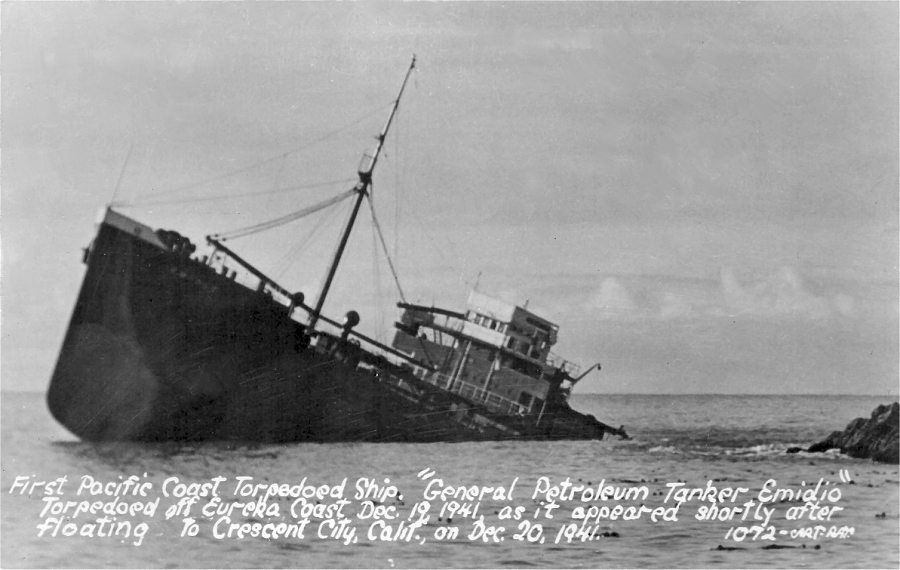 THAILAND The Japanese and Thai governments sign a ten-year Treaty of Alliance at Bangkok. The Thais acknowledge their debt to the Japanese in light of the Treaty of Tokyo and the transfer of territory from French Indo-China to Thailand.
|
|
lordroel
Administrator
Posts: 68,093 
Likes: 49,488
|
Post by lordroel on Dec 21, 2020 3:49:23 GMT
Day 843 of World War II, December 21st 1941Eastern FrontSoviet 31st Cavalry Division attacks Kaluga, 60 miles Northwest of Tula, but they are held by German 137th Infantry Division. Both sides are ordered to hold the town at all costs, beginning a week of hand-to-hand fighting. Photo: Horsemen of the 1st Guards Cavalry Corps of General Pavel Alekseevich Belov enter the city of Odoev. In the foreground is a captured German 37 mm PaK 35/36 anti-tank gun. Odoev, Tula region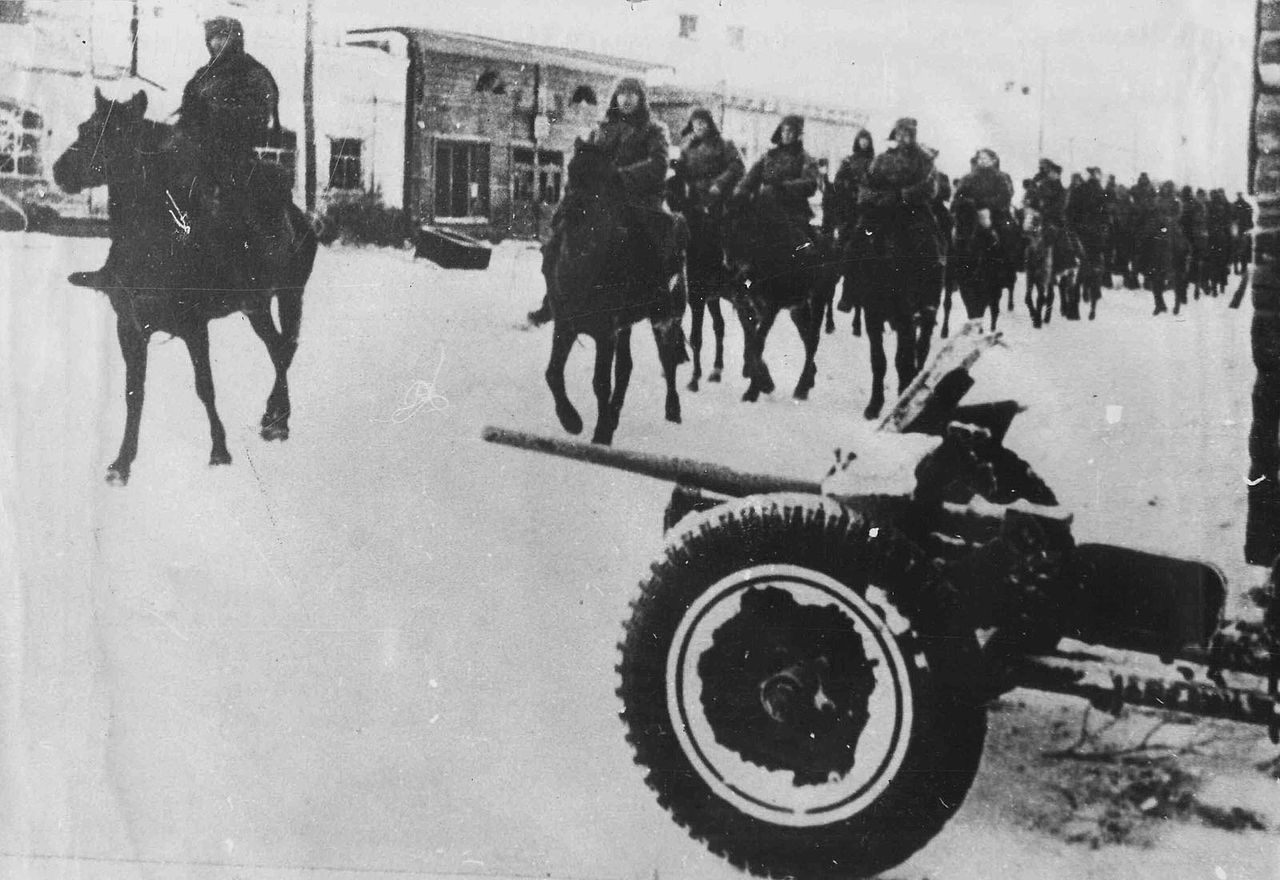 Battle of the Atlantic Battle of the Atlantic The German submarine 'U-751' puts three torpedoes into British escort aircraft carrier HMS 'Audacity' (D 10) causing her to sink about 441 nautical miles (817 kilometers) northeast of Lagens Field, Azores Islands, in position 43.45N, 19.54W. In the general counter-attack, German submarine 'U-567' is detected and sunk by depth charges from the British sloop HMS 'Deptford '(U 53) and corvette HMS 'Samphire' (K 128 ) about 444 nautical miles (822 kilometers) northeast of Lagens Field in position 44.02N, 20.10W; all 47 crewmen on the U-boat are lost. All of the British vessels are escorting convoy HG76 (Gibraltar to the U.K.). The USN light cruiser USS 'Omaha' (CL-4) and destroyer USS 'Somers' (DD-381), operating out of Recife, Brazil, encounter a darkened ship that acts suspicious and evasive when challenged. USS 'Omaha' fires a starshell and illuminates the stranger; USS 'Somers' sends an armed boarding party that learns that the merchantman nearly fired upon is the Soviet freighter SS 'Nevastroi'. Western Desert Campaign - Operation CrusaderWhile Indian 4th Division is grounded on the coast road at Derna for lack of fuel, Allied motorised infantry chase retreating German and Italian armor across the desert tracks South of Green Mountain towards Beda Fomm. Battle of the MediterraneanGerman submarine 'U-451' is sunk about 18 nautical miles (33 kilometers) west-northwest of the Tangier Zone in position 35.55N, 06.08W, by depth charges from a British Fleet Air Arm Swordfish Mk. I, aircraft of No. 812 Squadron based at Gibraltar. The Swordfish is equipped with air-to-surface vessel (ASV) radar. This is the first submarine to be destroyed by an aircraft at night. Only one of the 45 man crew in the U-boat survives. Pacific War MALAYA The Indian 11th Division takes command of all troops west of the Perak River, including those on Grik road, who are still heavily engaged, and begins a withdrawal behind Perak the River. PACIFIC OCEAN In the South China Sea, the Dutch submarine HNLMS K XVII strikes a Japanese mine and sinks about 115 nautical miles N of Singapore, Malaya, in position 03.10N, 104.12E. All 36 crewmen are lost. Photo: K XVII together with minelayer HNLMS Medusa in the period 1940 to 1941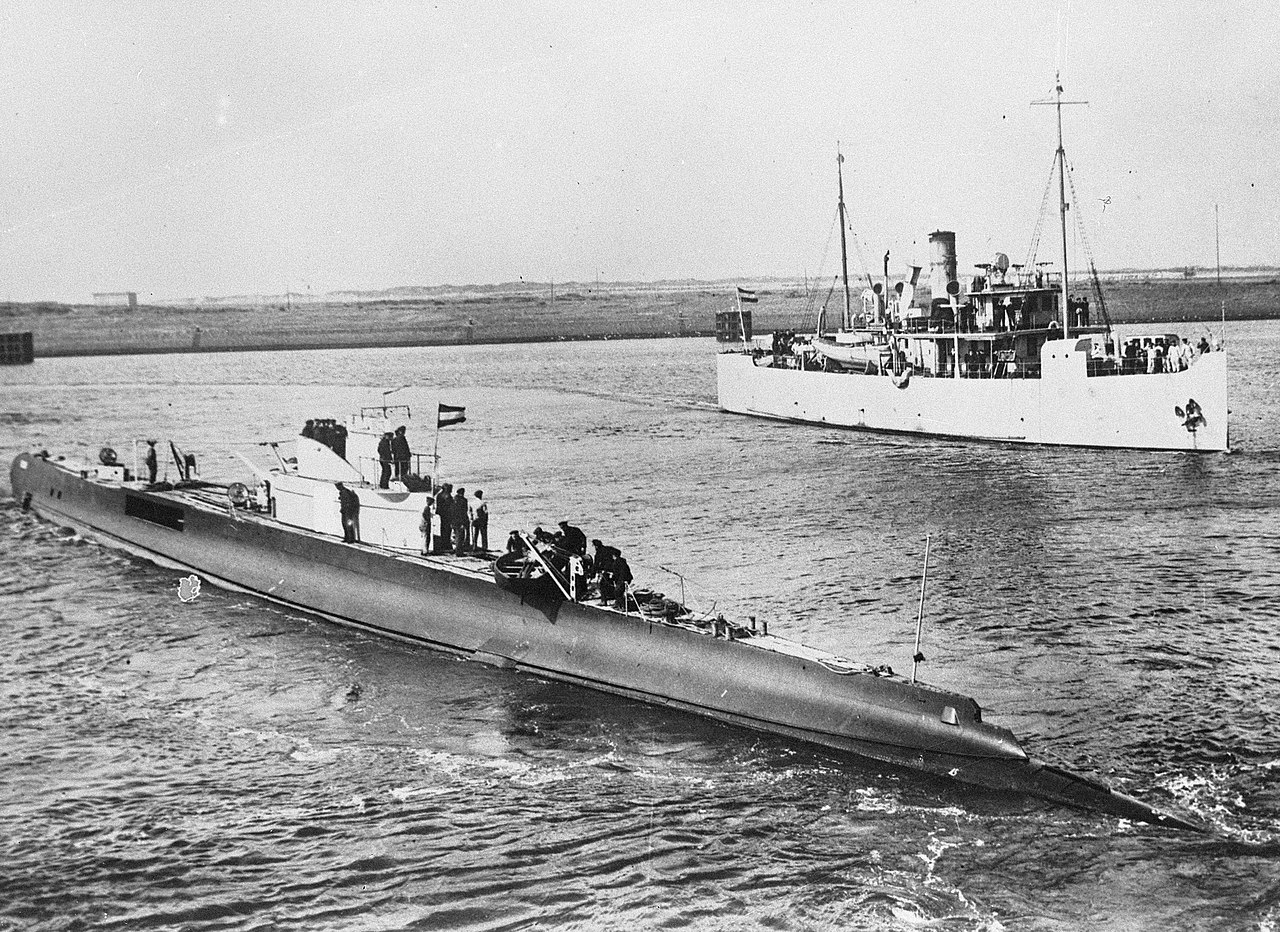 PHILIPPINE ISLANDS Three Japanese convoys from Formosa and the Pescadores, bearing the main body of the Japanese 14th Army assault force, arrive in Lingayen Gulf, Luzon, during the night of 21/22 December. Meanwhile, the Filipino 11th Division makes contact with the Japanese Vigan force at Bacnotan. Naval local defense forces in Philippine Islands (Rear Adm. F. W. Rockwell) move headquarters to Corregidor. WAKE ISLAND The PBY-5 Catalina that arrives yesterday takes off at 0700 hours; aboard is Major Walter Bayler of Marine Aircraft Group Twenty One, "the last man off Wake." Japanese concern over the potential presence of patrol planes at Wake, occasioned by the large amount of radio traffic that accompanies the sole PBYs arrival at the island, prompts advancing the date of the first carrier strikes. At 0850 hours, 29 Japanese carrier aircraft escorted by 18 "Zero" fighters from aircraft carriers Soryu and Hiryu, attack ground targets. At 1200 hours, 33 "Nell" bombers from Roi Airdrome in Kwajalein Atoll, Marshall Islands, bomb the island. The Wake Island relief force, Task Force Fourteen, is within 600 nautical miles of the island. The task force is composted of the aircraft carriers USS Lexington and Saratoga, the heavy cruisers USS Astoria, Minneapolis and San Francisco, ten destroyers, the seaplane tender USS Tangier and the oiler USS Neches. The convoy is carrying the 4th Marine Coastal Defense Battalion, Marine Fighting Squadron Two Hundred Twenty One equipped with F2A-1 Buffalo fighters, along with 9,000 five-inch rounds, 12,000 three-inch rounds, and 3 million 50 caliber rounds as well as a large amount of ammunition for mortars and other battalion small arms.
|
|
lordroel
Administrator
Posts: 68,093 
Likes: 49,488
|
Post by lordroel on Dec 22, 2020 3:54:29 GMT
Day 844 of World War II, December 22nd 1941Eastern FrontSiege of Leningrad Day 106. The ice on Lake Ladoga is 1 meter thick, enough to support 45-ton KV tanks which are moved along the Road of Life to aid in the defense of the city. Trucks bring in 687 tons of food, for the first time exceeding Leningrad’s daily consumption of 600 tons. Photo: Luftwaffe aerial reconnaissance photo of a section of the Leningrad Ice Road, 60 km east of Leningrad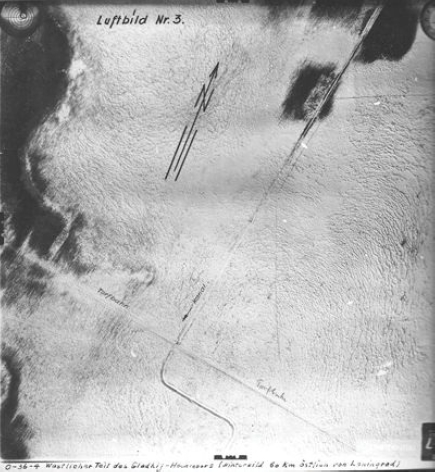 United States/United Kingdom relations United States/United Kingdom relations The Anglo-American conference (ARCADIA) opens in Washington, D.C. to deal with war strategy. U.S. President Franklin D Roosevelt, British Prime Minister Winston S Churchill, Harry Hopkins, Lord Beaverbrook, and American and British Chief of Staffs participate. They confirm the policy from Placentia Bay, Newfoundland, in August1 1941 of attacking Germany first. They also establish the Combined Chiefs of Staff (CCS) for the entire Allied military effort. A general strategic program is approved of a U.S. buildup in the United Kingdom and continuing the bombing offensive. The concept of further losses in the Pacific is accepted with the understanding that a stiff defense will hold these to a minimum. Roosevelt also agrees to a radical increase in the U.S. arms production program: the 12,750 operational aircraft to be ready for service by the end of 1943 became 45,000; the proposed 15,450 tanks also became 45,000; and the number of machine guns to be manufactured almost doubled, to 500,000. Western Desert Campaign - Operation CrusaderAllied motorised infantry reach Beda Fomm but run into 30 new Panzers placed to prevent them cutting off the German/Italian infantry retreat along the coast. Axis forces begin evacuating Benghazi, sending small convoys by sea to Tripoli. A newly-laid Italian minefield off Misrata sinks German steamer Spezia and Italian steamer Umbra Cadamosto. Photo: A member of the crew of an Italian M13/40 tank giving himself up near Gazala. His captor might be a soldier of the Polish Independent Carpathian Rifles Brigade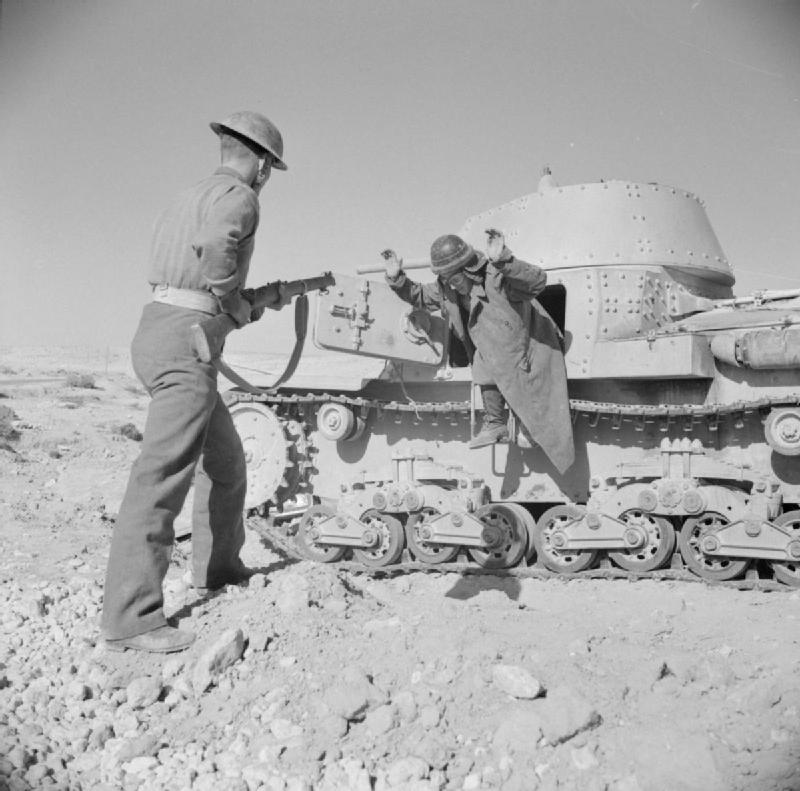 Pacific War Pacific War AUSTRALIA Detailed designs begin on the Commonwealth Aircraft Corporation Boomerang Fighter. The aircraft will be test flown 22 weeks later! The man responsible is CAC chief engineer, Fred David who is a German jew who previously worked for heinkel in Germany and later the Japanese Aircraft Company before fleeing Japan as a refugee as it established military links with Nazi Germany. As such Fred David was considered officially as an “unfriendly” alien, and was required to report to the police every fortnight. Richard G. Casey, Australian Minister to the U.S., reports to his government that President Roosevelt might press to have an American accepted as the commander-in- chief of a Pacific and Far East theater and that Lieutenant General Douglas MacArthur, commanding the US Army Forces Far East in the Philippines, might be nominated. Casey suggests that it might be advantageous for the Australian government to suggest an American as commander-in- chief. The USN's "Pensacola" Convoy, consisting of the heavy cruiser USS Pensacola, the gunboat USS Niagara, the transports USS Chaumont and Republic, the Army transports USAT Meigs and Willard A. Holbrook, the U.S. freighters SS Admiral Halstead and Coast Farmer and the Dutch freighter MV Bloemfontein, arrive in Brisbane, Queensland. Brigadier General Julian F. Barnes' Task Force South Pacific is redesignated U.S. Forces in Australia (USFIA). This is the first U.S. troop detachment to arrive in Australia. RABAUL 12 Wirraways of 24 sqn RAAF, are transferred from Townsville to Rabual as part of Rabaul's air defense. CHINA At a meeting of Allied leaders in Chungking, Generalissimo Chiang Kai-shek offers the Chinese 5th and 6th Armies for the defense of Burma. British General Archibald Wavell, Commander-in- Chief, India accepts the Ch 6th Army's 93d Division, elements of which are approaching the border of Burma from China. A regiment of the 49th Division is to be held in reserve on the northern Burma frontier. HONG KONG The Japanese capture Sugar Loaf Hill at 1200 hours, but Canadians from C Company of the Royal Rifles recapture the hill; later taken out to Stanley Fort down the peninsula, for a rest; will hold out until their ammunition, food and water are exhausted. JAPAN The Japanese Navy postpones the shelling of U.S. cities on the west coast by nine submarine until 27 December. The original date was 25 December. MALAYA As the Indian 11th Division continues their withdrawal across the Perak River, the RAF begins a regular reconnaissance of the west coast to prevent Japanese landings. The Indian 9th Division completes their planned withdrawal in eastern Malaya to positions from which to defend Kuantan airdrome and protect the Indian 11th Division from an attack from the east. PACIFIC OCEAN Japanese submarine I-19 surfaces and shells an unarmed 10,763-ton U.S. tanker off the coast of California about 15 nautical miles WSW of Lompoc, California. The submarine breaks off the attack when a USN aircraft arrives and drops a depth charge allowing the tanker to escape. USN. submarine USS S-38, sailing from Manila, Philippine Islands, sinks a 5,445 ton Japanese transport in Lingayan Gulf. This is S-38's first war patrol and during the patrol she will fire torpedoes at five ships. USN Task Force Fourteen, the relief force for Wake Island, slows down to refuel. At Pearl Harbor, Vice Admiral William S. Pye, the temporary commander of the Pacific Fleet pending the arrival of Admiral Chester W. Nimitz, cannot make up his mind to risk what is left of the fleet. During the evening, a compromise is reached between Pye and Rear Admiral Frank Jack Fletcher, commander of TF 14. Tomorrow, the F2A Buffalos of Marine Fighting Squadron Two Hundred Twenty One in aircraft carrier USS Saratoga, would be flown off at maximum range. The seaplane tender USS Tangier is carrying 300 marines of the 4th Defense Battalion, including two batteries and detachment of to other batteries, plus ground elements of VMF-221, a radar set, and 21,000 rounds of 3-inch and 5-inch ammunition and 3 million rounds of machine gun ammunition, would make a speed run to Wake while the remainder of Task Force 14 retired with Task Force 11 built around the aircraft carrier USS Lexington. PHILIPPINE ISLANDS The Japanese begin their main landings along the coast of Lingayen Gulf on Luzon before dawn. One assault force goes ashore near Bauang, another at Aringay, and a third near Agoo. They move forward at once without serious opposition from 11th and 21st Divisions (Philippine Army). The 71st Infantry Regiment, 71st Division (Philippine Army), and 26th Cavalry Regiment (Philippine Scouts) moveout to help halt the Japanese. The Bauang assault force seizes that town, effects a junction with the Japanese Vigan force at San Fernando, La Union, and pushes inland toward Baguio, while the other forces overrun Rosario and face south toward Manila. U.S. submarines and a few aircraft attack enemy armada in Lingayen Gulf. Nine Far East Air Forces B-17 Flying Fortresses from Batchelor Field near Darwin, Northern Territory, Australia, attack shipping in Davao Bay, Mindanao Island and land at Del Monte Field on Mindanao Island. This is the first action in the Philippines by Australian-based planes. HQ 7th BG (Heavy) and the ground echelon of it's 9th, 11th and 22d Bombardment Squadrons (Heavy) and attached 88th Reconnaissance Squadron (Heavy) arrive at Brisbane, Australia from the US. The air echelons of the 9th and 11th are enroute from the US to Australia with B-17's; the air echelons of the 22d and 88th are operating from Hickam Field, Oahu, Territory of Hawaii until 5 January 1942 and 10 February 1942 respectively with B-17's. The 16th, 17th and 91st Bombardment Squadrons (Light), 27th Bombardment Group (Light) transfer from Ft William McKinley to Lipa Airfield, San Fernando and San Marceleno respectively without aircraft. WAKE ISLAND Japanese bombers and attack planes, covered by fighters, from the aircraft carriers Hiryu and Soryu, bomb Wake Island for the second time; the last two flyable USMC F4F Wildcats intercept the raid. One F4F is shot down, the other is badly damaged. During the night of 22/23 December, Task Force 14, the relief force for Wake, is order to withdraw to Pearl Harbor. Task Force 11, built around the aircraft carrier USS Lexington (CV-2), is also ordered to return to Pearl Harbor.
|
|
lordroel
Administrator
Posts: 68,093 
Likes: 49,488
|
Post by lordroel on Dec 23, 2020 3:51:00 GMT
Day 845 of World War II, December 23rd 1941Eastern FrontThe outer ring of Russian forts around Sevastopol is finally captured by the Germans. Photo: Soldiers from German supply units take cover among the rocks near Sevastopol Siege of Leningrad Day 107. Trucks bring 786 tons of food across Lake Ladoga. Although many inhabitants still face death from inadequate rations and cold, the city is saved from starvation. The Road of Life can support railway freight cars which are towed out carrying machinery; 3677 railway cars haul out much of Leningrad’s industrial equipment between December 1941 and April 1942. Battle of the MediterraneanGerman submarine 'U-79' is sunk about 69 nautical miles (129 kilometers) east of Tobruk, Libya, in position 32.15N, 25.19E,, by depth charges from the British destroyers HMS 'Hasty' (H 24) and 'Hotspur' (H 01); all 44 crewmen survive. At 7.02 PM 29 miles East of Tobruk, U-559 sinks British passenger ship SS Shuntien carrying 1100 German and Italian POWs from Tobruk to Alexandria, plus 70 crew and 18 gunners (6 crew and 700 POWs killed). 64 crew and 400 POWS rescued by British corvette HMS Salvia and destroyer HMS Heythrop. In the same area, 40 miles North of Sollum, Egypt. Photo: The passenger and cargo liner SS Shuntien, built in 1934 for the China Navigation Co. Note her icebreaker bow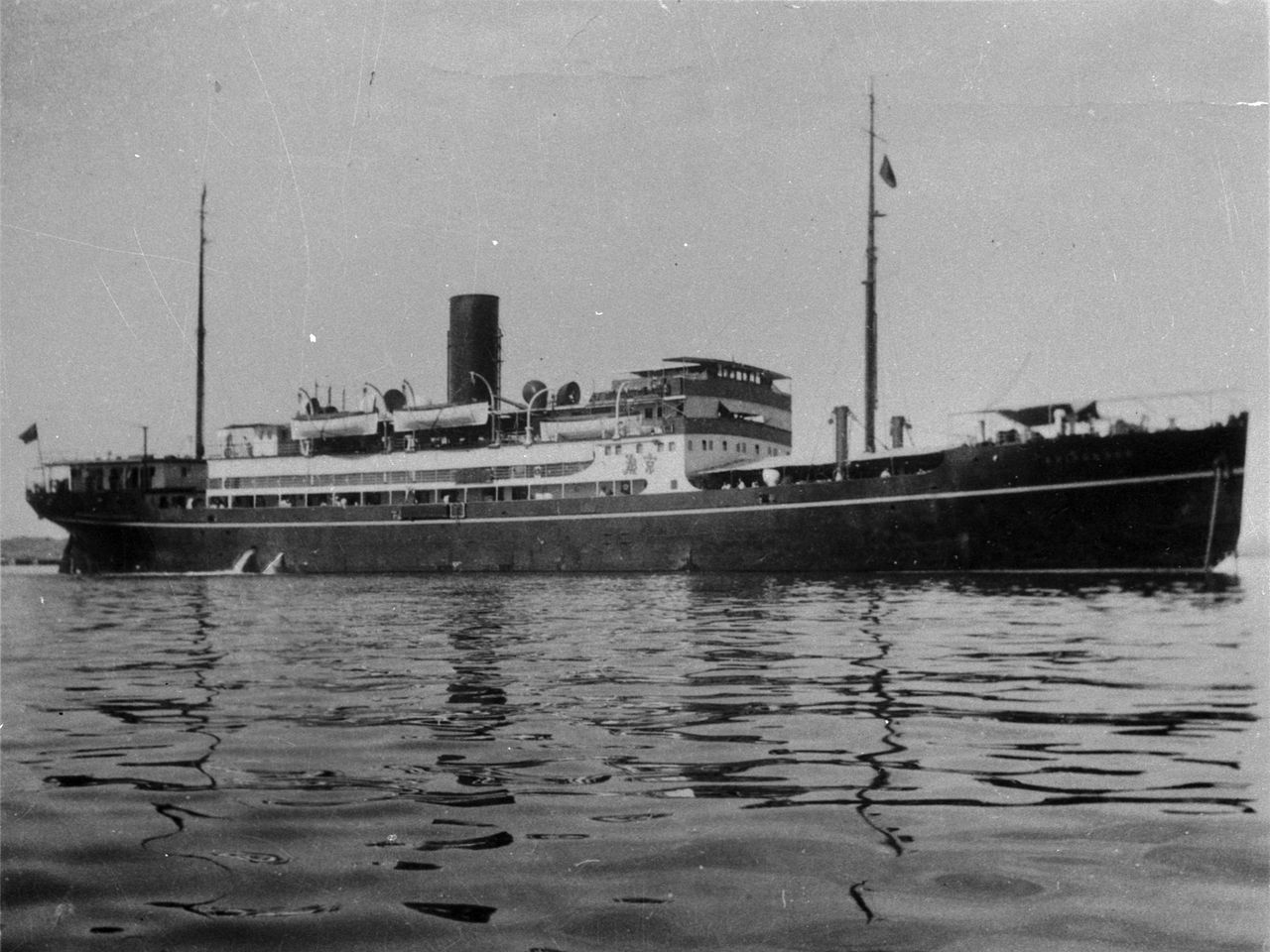 Western Desert Campaign - Operation Crusader Western Desert Campaign - Operation CrusaderBecause of supply difficulties, which increase as pursuit progresses westward, elements of XIII Corps, British Eighth Army, are forced to remain in place. However, the Indian 4th Division seizes Barce, on the coast, and forward elements of the 7th Armoured Division force the Germans to retire from Antelat to Agedabia. Free FrenchFree French Naval Forces take possession of the two islands of Saint Pierre and Miquelon off the south coast of Newfoundland without firing a shot. A strong protest is lodged by U.S. Secretary of State Cordell Hull but after several weeks of bickering between U.S., Canadian and British diplomats and "the so called Free French" as Hull describes them the coup remains a fait accompli. Pacific WarAUSTRALIA The Advisory War Council agrees that the future of Australia is bound up with the talks taking place during the Arcadia Conference in Washington, D.C., and Prime Minister John Curtin cables U.S. President Franklin D. Roosevelt and British Prime Minister Winston Churchill appealing for more reinforcements for Singapore, Malaya. At the same time, Curtin tells Roosevelt that if the U.S. government wants, Australia would gladly accept an American commander in the Pacific. The USAAF Far East Air Force (FEAF) comes under control of the newly created US Forces in Australia (USFIA). Major General Lewis H Brereton, Commanding General FEAF, receives orders establishing HQ FEAF at Darwin, Northern Territory. BORNEO The Japanese invasion convoy which left Miri in the British protectorate of Sarawak yesterday, is being escorted by the five heavy cruisers, two light cruisers, six destroyers, two minesweepers and an aircraft depot ship. Part of the escort force is sighted this morning when it is about 150 miles off Kuching, capital of Sarawak. At 1140 hours, 24 Japanese aircraft bomb Singkawang II Airfield in Dutch Borneo, so damaging the runways that a Dutch striking force which has been ordered to attack the convoy is unable to take off with a bomb load. Despite the critical situation the Dutch authorities urge the transfer of their aircraft to Sumatra, Netherlands East Indies. Air Headquarters, Far East, agrees and tomorrow afternoon, the aircraft were flown to Palembang. The Japanese convoy does not escape unscathed. This evening, it is attacked by Dutch submarine HNLMS K-XIV which sinks two transports and damages a transport and a tanker. Photo: HNLMS K-XIV before the outbreak of the war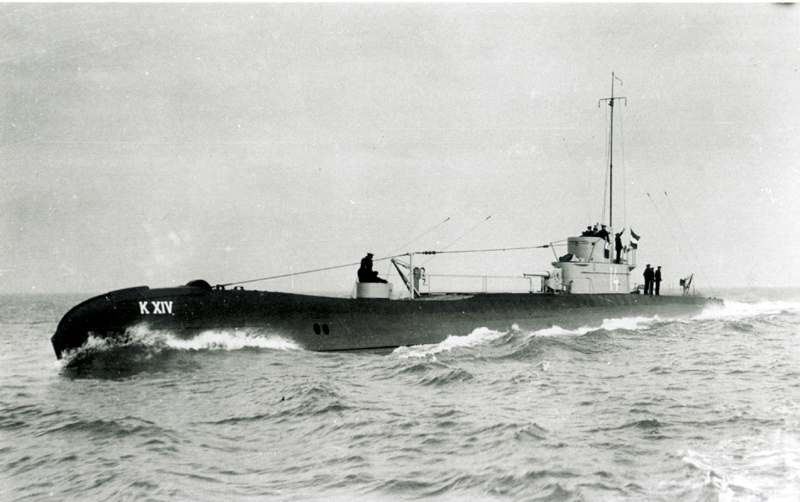 During the night of 23/24 December, submarine Dutch HNLMS K XVI torpedoes and sinks the Japanese destroyer Sagiri. Fires rage on the destroyer igniting the torpedoes and the ship blows up killing 121 of the 241 crewmen. Photo: The Dutch submarine HNLMS K-XVI on the surface in Netherlands East Indies (NEI) waters before the outbreak of the war During the evening, five RAF Blenheim Mk. IVs of No. 34 Squadron based at Tengah Airfield, Singapore, Malaya, operating at extreme range, bomb the ships at anchor in Kuching harbor but do little damage. Photo: Bristol Blenheim Mark IVs taxying out for an air-test after assembly at RAF Tengah, Singapore, following their urgent shipment to the theatre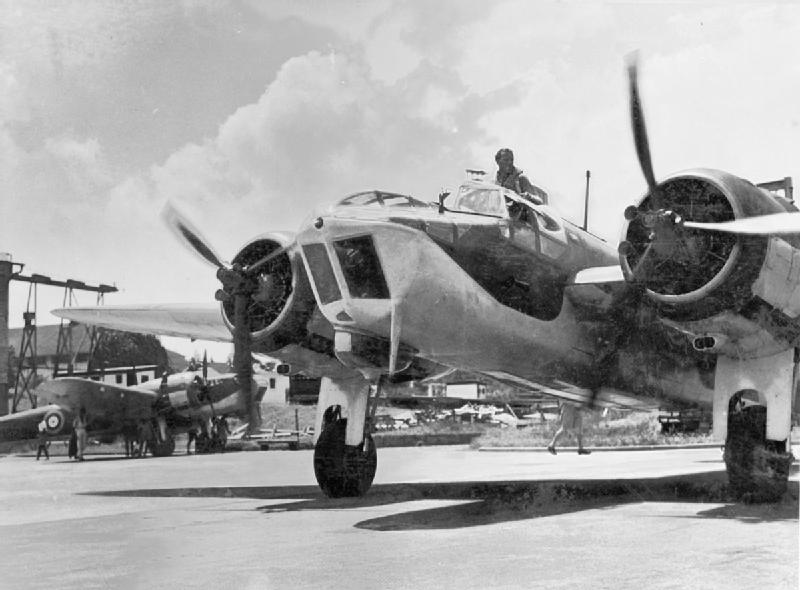 BURMA Rangoon feels the first of the Japanese air strikes. There are three Allied fighter squadrons available: RAF No. 60 Squadron with Blenheim Mk. I light bombers and (USN F2A) Buffalo Mk. Is and No. 67 Squadron with Buffalo Mk. Is, and the 3d Squadron, American Volunteer Group (AVG or "Flying Tigers") with P-40Bs. These fighters are only able to offer token resistance to the Japanese. An exodus of civilian laborers hampers port operations in Rangoon. Chuck Baisden, who was an armorer with the 3d Squadron, AVG, writes this first hand report: at our base at Mingaladon Airdrome just outside of Rangoon as one of the armorers in the 3d Squadron AVG (Hell's Angels), we had completed our morning preflight and a number of us crew chiefs, armorers and radio men were standing around on a small knoll just outside our barracks and perhaps a hundred odd feet from our flightline dispersal area when the air raid siren went off with our pilots racing to their planes, starting engines and immediately taxiing to the active runway and taking off. It was a miracle there were no mid air collisions as some 14 P-40B fighters were taking off from one direction sandwiched between a number of RAF Buffaloes (I believe they were New Zealand pilots) taking off from another dispersal area in almost opposite directions. It was right hairy for a spell. Things got quiet and then from a distance we saw a rather large formation approaching our field, flying in a tight three ship V of V formation with fighter escorts swarming like a bunch of bees. Turned out there were 54 Japanese "Betty" bombers (Mitsubishi G4M, Navy Type 1 Attack Bombers) and some 40 fighters. One of our guys started counting and when he hit 27 yelled "Hell they are not ours, we don't have that many." There was an immediate mad dash for some slit trenches a few feet from where we had been standing. One group of the bombers targeted our field and laid their pattern precisely down the runway and through our dispersal area. I remember those black dots getting larger and larger accompanied by a "whoose- whoose" sound and thought they were all aimed directly at me. It was nothing compared to the shock of the bombs as they walked up the field with the noise getting louder and louder. The concussion bounced us around in the trench and from the smell someone had voided in his trousers. I know one 21-year-old that grew up in a hurry. Saw a parachute coming down with a Japanese "Nate" fighter (Nakajima Ki-27, Army Type 97 Fighter) making a pass at the helpless guy in a parachute. Luckily one of the RAF pilots saw what the Japanese pilot was up to and forced him to break off. Neil Martin, my pilot at Langley Field, Virginia, and Mitchel Field, New York, USA, when we were pulling tow targets in an old Martin B- 10 bombers, made a pass at the bomber formation and never pulled out of his dive, evidently killed by a bomber gunner. Henry Gilbert was also shot down and killed. My comrade-in arms R.T.Smith (Tadpole) shot down two or three and landed with his fuselage full of holes, a present from a Japanese bomber gunner. I had the privilege to fly as his gunner in B-25 Mitchells with the Air Commando Group two years later. Score for this day was 15 Japanese aircraft and we lost three P-40s and two pilots. There are a number of casualties among support personnel in the RAF at our field and some 1,000 civilians were killed or wounded in Rangoon. CHINA The Japanese begin a drive on Changsha in Hunan Province. HONG KONG Allied troops withdraw to the last fortified line "The Ridge", a large hill at the neck of the Stanley Peninsula. The island is lost but they intend to make stand in the vain hope of assistance from Chinese troops on the mainland. LINE ISLANDS The U.S. Palmyra Island is shelled by Japanese submarines I-71 and I-72. Palmyra Island is located about 957 nautical miles SSW of Honolulu, Oahu, Territory of Hawaii. MALAYA The Indian III Corps completes a withdrawal of all west coast forces behind the Perak River during the night of 23/24 December. Japanese planes, which so far have concentrated on airfields, begin intensive action against forward areas. PACIFIC OCEAN Two Japanese submarines attack U.S. merchant ships off the coast of California, U.S.A.: (1) I-21 attacks two ships; (1) she fires a torpedo at a 6,418 ton unarmed U.S. tanker about 17 nautical miles WSW of Pismo Beach, California but the tanker escapes and she later torpedoes and sinks an 8,272 ton unarmed U.S. tanker about 19 nautical miles WNW of Morro Bay, California; (2) I-17 surfaces and shells an unarmed U.S. tanker located about 62 nautical miles SW of Eureka, California, but the tanker escapes. Uncertainty over the positions of and number of Japanese carriers and reports that indicate Japanese troops have landed on Wake Atoll compel Vice Admiral William S. Pye, Acting Commander in Chief Pacific Fleet, to recall Task Force 14 (Rear Admiral Frank Jack Fletcher) while it is 425 nautical miles from its objective. PHILIPPINE ISLANDS On Luzon, Lieutenant General Douglas MacArthur, Commanding General US Army Forces Far East, decides to evacuate Manila and withdraw to Bataan Peninsula to make a delaying stand. During the night of 23/24 December, a Japanese invasion force of 7,000 men arrives in Lamon Bay from the Ryukyu Islands. Another Japanese invasion force sails from Mindanao Island for Jolo Island in the Sulu Archipelago. After 0000 hours, four of the Far East Air Force's B-17 Flying Fortresses take off from Del Monte Field on Mindanao Island and bomb shipping in Lingayen Gulf, Luzon. They damage a destroyer and a minesweeper. After the attack, one aircraft lands at Del Monte Field and the other three land on Ambon Island in the Netherlands East Indies. After refueling, all four proceed to Batchelor Field near Darwin, Northern Territory, Australia. Twelve P-40s and six P-35s, the only USAAF fighter aircraft in the Philippines, strafe Japanese forces landing in San Miguel Bay on Luzon. Using a P-26A Peashooter, of the Philippine 6th Pursuit Squadron, Lieutenant Jose Kare shoots down a Japanese "Zero" fighter . UNITED STATES California Governor Culbert Olson, at the request of Lieutenant General John. DeWitt, Commanding General Fourth Army and Commanding General Western Defense Command, bans the sale of liquor to persons in uniform, except between 1800 and 2200 hours. WAKE ISLAND At 0300 hours, 1,500 Japanese troops land on the island and after an 11-hour fight, the garrison surrenders. The garrison consists of marines, sailors, volunteer civilians (Contractors Pacific Naval Air Bases) and a USAAF radio detachment. Forty-nine Marines, three sailors, and about 70 civilians (there were many civilian construction workers on Wake) are killed during the battle. Japanese Patrol Boat No. 32 and Patrol Boat No. 33 (old destroyers converted to high speed transports) intentionally run ashore to facilitate the landing of troops, are destroyed by marine shore batteries (1st Defense Battalion). Photo: Japanese Patrol Boat No.32 (left) and Patrol Boat No.33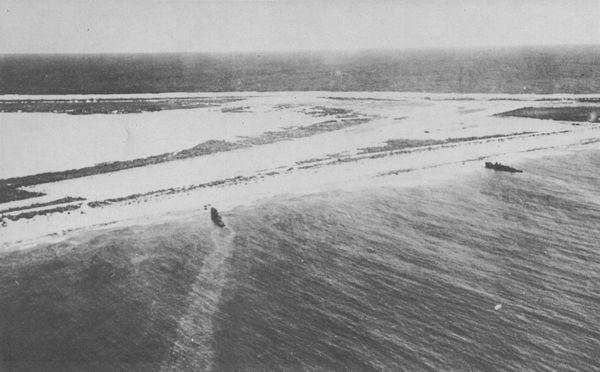 Planes from aircraft carriers Hiryu and Soryu, as well as seaplane carrier Kiyokawa Maru provide close air support for the invasion. Open cargo lighter YCK 1 is lost to Japanese occupation of the atoll, as are civilian tugs Pioneer and Justine Foss, and dredge Columbia.
|
|
lordroel
Administrator
Posts: 68,093 
Likes: 49,488
|
Post by lordroel on Dec 24, 2020 3:16:37 GMT
Day 846 of World War II, December 24th 1941Battle for the AtlanticThe third German submarine involved in Operation Drumbeat, 'U-66', sets sail from Lorient for North America. Battle of the MediterraneanAt 1.35 AM 50 miles Northeast of Mersa Matruh, Egypt, U-568 sinks British corvette HMS Salvia (all 106 hand lost, plus an unknown number of survivors rescued a few hours earlier from British passenger ship SS Shuntien transporting German and Italian POWs from Tobruk to Alexandria). Photo: "HMS Kingston on anti-submarine patrol, eastern Mediterranean, this photo was taken aboard Dutch destroyer HNLMS Isaac Sweers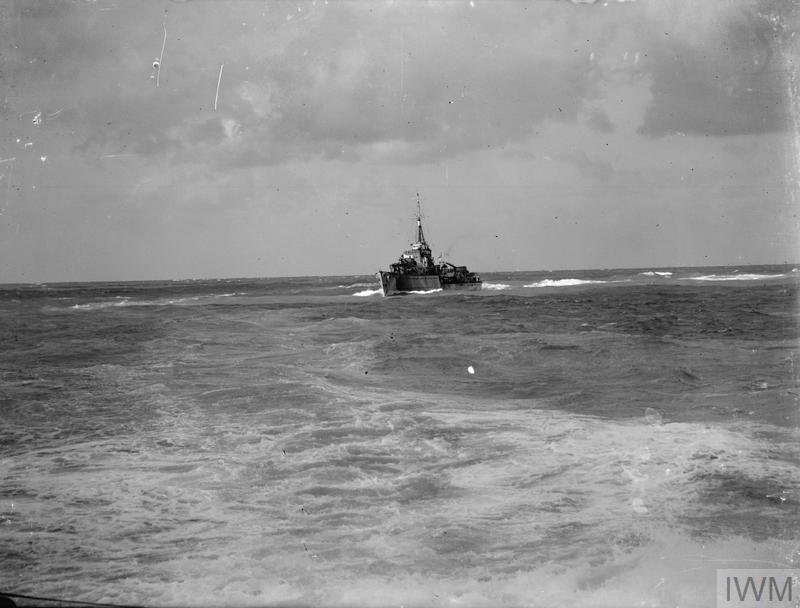 Western Desert Campaign - Operation Crusader Western Desert Campaign - Operation CrusaderA detachment of the 7th Armoured Division, XIII Corps, British Eighth Army, enters Benghazi and finds that the Germans have withdrawn. Photo: men of 'A' Squadron, Central India Horse, Cyrenaica, December 1941 near Benghazi 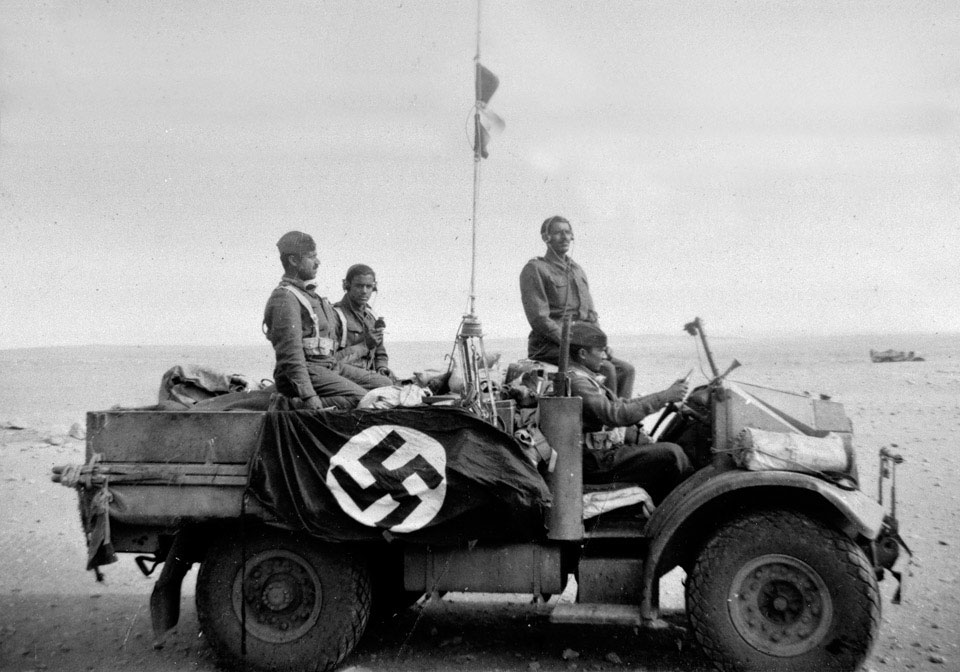 United States United StatesThe USN commissions the light cruiser USS 'Atlanta'(CL-51) at the New York, New York Naval Shipyard. The USN now has 20 light cruisers in commission. Photo: USS Atlanta when she was running trials off Rockland, Maine, November 26th 1941 United Kingdom United KingdomThe Avro Lancaster Mk. I enters service with No. 44 Squadron at RAF Waddington, Lincolnshire, England. The Lancaster does not make its operational debut until 3 March 1942. Pacific WarAUSTRALIA U.S. Brigadier General Henry B. Claggett takes temporary command of U.S. Forces in Australia, pending the arrival of Major General George H. Brett from Chungking, China. BORNEO A Japanese convoy, despite attacks by British and Dutch planes and Dutch submarines, succeeds in landing troops in the Kuching area of the British protectorate of Sarawak, early in morning. The garrison, having already destroyed Kuching airdrome, requests permission to withdraw to Dutch Borneo and is told to delay the Japanese as long as possible before retiring. Dutch aircraft withdraw from Singkawang, Borneo, to Palembang, Sumatra. HONG KONG The British defenders are split in two, and are short of water. Japanese troops capture 53 British and Canadian soldiers, rope them together, and shoot or bayonet them to death. In the village of Stanley, the Japanese attack doctors and wounded soldiers in St. Stephen's College Emergency Hospital, bayoneting more than 50 men in their beds. The British destroyer HMS Thracian runs aground and is captured by the Japanese. She is salvaged by the Japanese Navy, repaired and recommissioned on 25 November 1942 as Patrol Vessel No.101, then re-rated a training ship in March 1944, being attached to the torpedo school at Yokosuka. Recaptured in 1945, she is eventually broken up at Hong Kong post-war. MALAYA The Indian 11th Division, controlling all Indian III Corps troops north of the Slim and Bernam Rivers, is organizing a defense in depth astride the main road with the main line of resistance in the Kampar area and rear positions near the Slim River. Commander Australian Imperial Force Malaya, Major General Gordon Bennett (General Office Commanding Australian 8th Division), assigns responsibility for North Johore to the Australian 27th Brigade Group, 8th Division. British air strength in Malaya has been reduced to 38 fighters, 40 dive bombers, 34 torpedo bombers, 17 reconnaissance aircraft and 17 others. MIDWAY ISLANDS USN seaplane tender USS Wright disembarks Marine reinforcements (Batteries "A" and "C," 4th Defense Battalion). PACIFIC OCEAN Two U.S. merchant vessels are shelled by Japanese submarines off the coast of California: - I-17 shells a 5,695 ton unarmed freighter about 19 nautical miles (36 kilometers) north-northwest of Catalina Island which is about 14 nautical miles SW of Long Beach, California. Although the freighter is abandoned, she is later reboarded and towed to San Pedro, California. - I-23 shells a 2,119 ton unarmed freighter off Monterey Bay south of San Francisco. The ship escapes. PHILIPPINE ISLANDS On Luzon, Admiral Thomas C. Hart, commander of the Asiatic Fleet, releases the 4th Marine Regiment, stationed at Olongapo, to defend the beaches of Corregidor. The Japanese Lamon Bay invasion force, which constitutes the southern prong of pincers applied against Manila, goes ashore early in morning at three points; Mauban, near Atimonan, and Siam. The main assault force, in the center, secures Atimonan, forcing the defenders back toward Pagbilao. The Mauban force takes that town and pushes 5 miles west. From Siam the Japanese advance in two columns, one southewest toward Tayabas Bay and the other southeast along Route 1 toward the Japanese Legaspi detachment. The Japanese on northern Luzon consolidate their beachhead and debouch on the central plain to thrust sharply toward the Agno River line. San Fabian and Binalonan fall, 26th Cavalry Regiment (Philippine Scouts) retiring from Binalonan across the Agno River to Tayug. The planned withdrawal toward Bataan is begun in the evening. U.S. Army, Far East headquarters, except for the rear echelon, and Manuel L. Quezon, President of the Commonwealth of the Philippines, and Francis B. Sayre, U.S. High Commissioner of the Philippines, sail to Corregidor from Manila. Photo: Lt. Gen. Masaharu Homma, 14th Army commander, coming ashore at Lingayen Gulf, 24 December 1941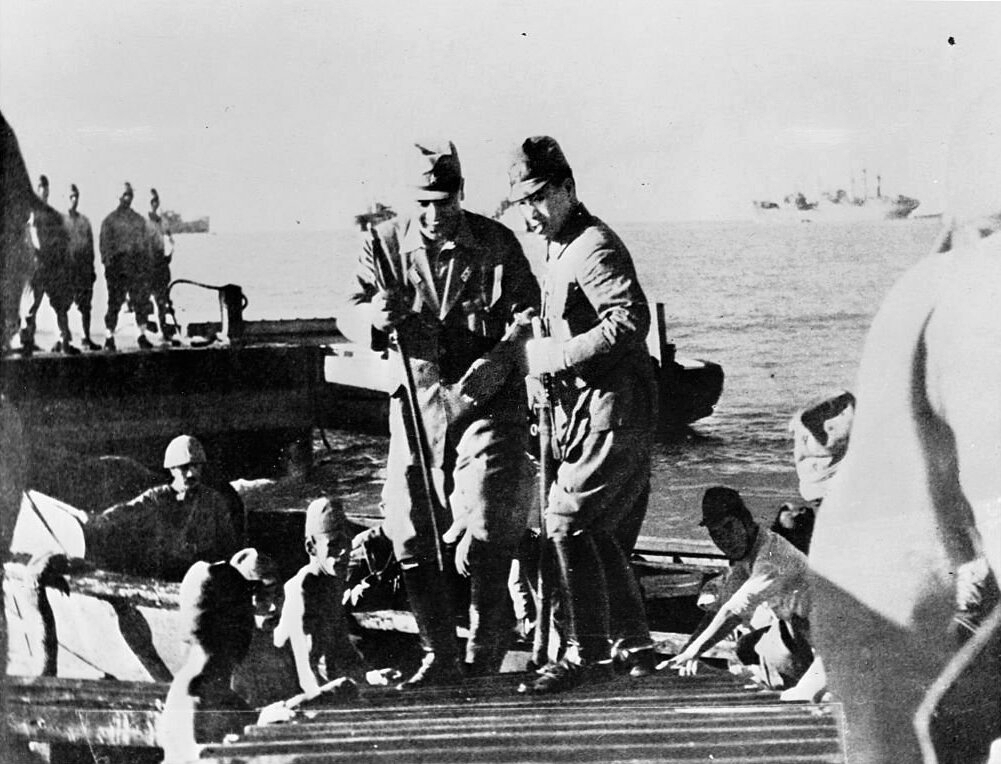 Fort Stotsenburg is evacuated. Major General Jonathan M. Wainwright's North Luzon Force, disposed generally along the line Tayug-Urdaneta- San Carlos-Aquilar, from east to west, begins withdrawing toward the Agno River line. The South Luzon Force, command of which passes from Major General George M. Parker to Brigadier General Albert M. Jones, is to withdraw northward into Bataan. General Parker moves to Bataan to head the Bataan Defense Force, organized to prepare defensive positions. In the Sulu Archipelago, the Japanese invade Jolo Island in the evening against light resistance from the constabulary. Jolo Island is located about half way between Borneo and Mindanao Island. Three USAAF Far East Air Force B-17 Flying Fortresses fly from Del Monte Field, Mindanao Island during the night of 24/25 December, bomb the airfield and shipping at Davao on Mindanao Island and land at Batchelor Field near Darwin, Northern Territory, Australia. Two USN PBY Catalinas leave Manila, Luzon, for Darwin with personnel of HQ Far East Air Force. Army Air Forces units on Luzon, as well as ground forces, begin moving to Bataan Peninsula. Photo: Damage caused by a Japanese air raid on the Manila port area. This photo was taken on 24 December 1941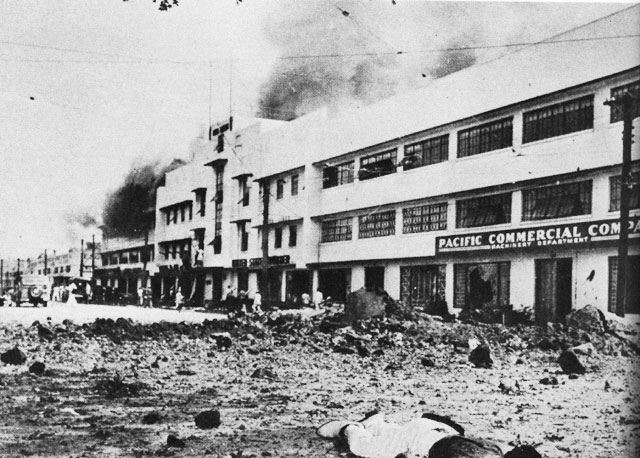
|
|
lordroel
Administrator
Posts: 68,093 
Likes: 49,488
|
Post by lordroel on Dec 25, 2020 9:53:32 GMT
Day 847 of World War II, December 25th 1941Eastern FrontThe Soviet winter offensives continue to gain ground. The Germans have lost significant strength at approximately 75 percent of their June strength. Guderian has less than 40 panzers available. Western Desert Campaign - Operation CrusaderThe British 8th Army enters Benghazi and Agedabia. Pacific WarHONG KONG This evening the British surrender in Hong Kong. Photo: Major General Maltby discussing the arrangement of surrender with Japanese at Peninsula Hotel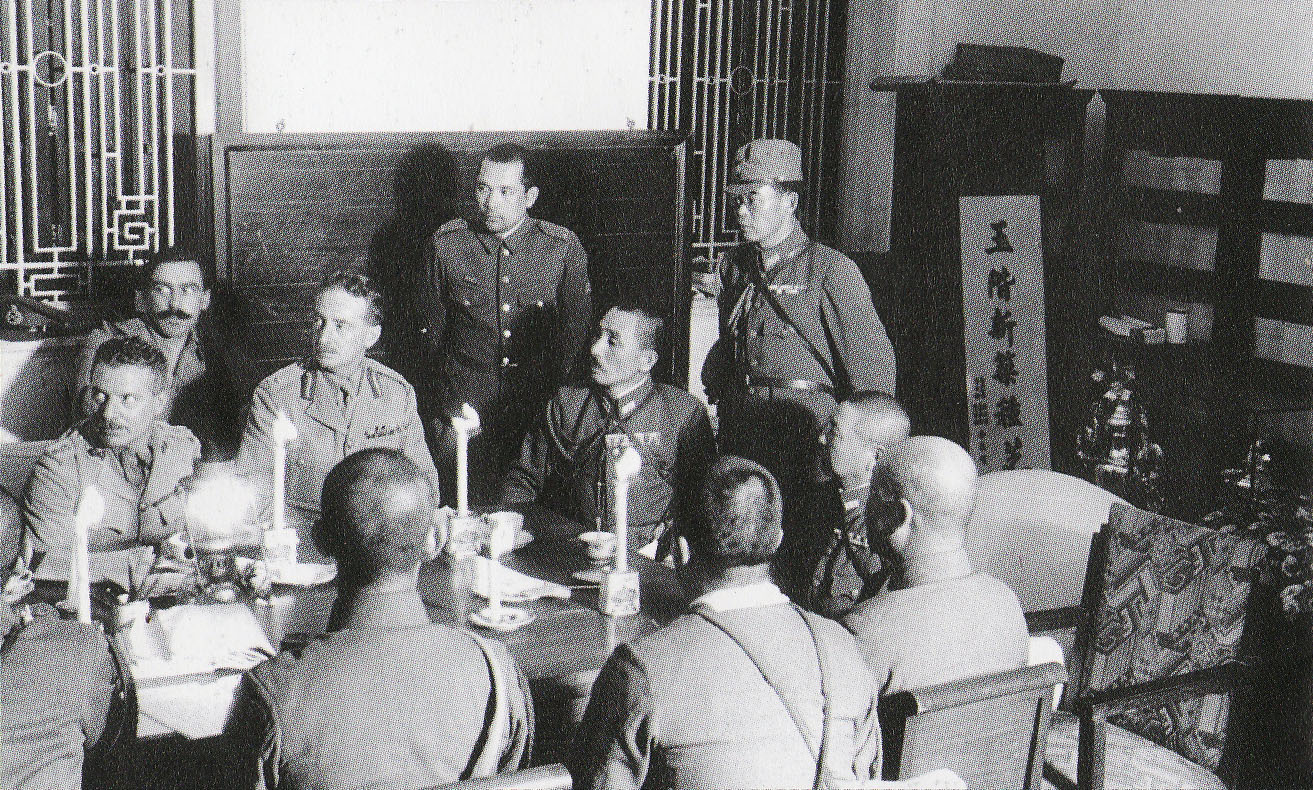 PHILIPPINE ISLANDS The US submarine Sealion, commanded by Richard C. Voge, is scuttled at Cavite, Manila Bay. This decision is implemented after aircraft damage on 10 Dec, 1941. There were 4 hands lost. Photo: Sealion (SS-195) photographed at the Cavite Navy Yard, Philippine Islands, after its capture by the Japanese Eight of the original 48 P-35As are left and the 34th Pursuit Sqdn is moved to Bataan. Photo: Damage to Cavite Navy Yard caused by Japanese bombing, late December 1941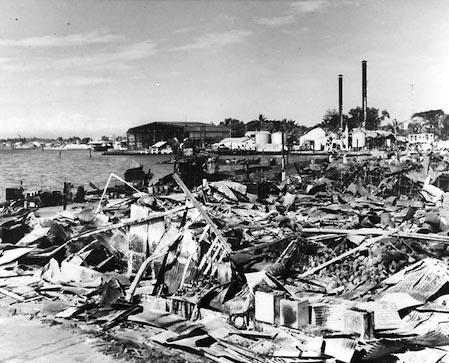 The US forces in northern Luzon are holding their 2nd defense line. The 3d, 17th, 20th, 21st and 34th Pursuit Squadrons (Interceptor), 24th Pursuit Group (Interceptor), transfer from Ternate, Nichols Field, Clark Field, Nichols Field and Del Carmen respectively to Bataan with P-35's and P-40's. The 17th and 20th begin operating from Lubao, Luzon with P-40's HQ 27th Bombardment Group and the ground echelon of it's 16th, 17th and 91st Bombardment Squadrons transfer from Lipa Airfield, San Fernando and San Marceleno respectively to Cabcaben, Luzon. AUSTRALIA Lieutenant Colonel Charles H. Caldwell sets up HQ Far East Air Force at Darwin Airfield. HQ V Bomber Command is also established at Darwin. The air echelons are operating from Brisbane, Australia; the ground echelons will fight as infantry on Luzon. BURMA Some 3 waves of 27 Sally Bombers with around 30 fighter escorts hit Rangoon and Mingaladon Airfield. There were no 3rd Squadron AVG losses, but the Japanese lost a confirmed 25 bombers and 10 fighters. Two of our 40s made belly landings after their engines had been hit. PALMYRA ATOLL Two-plane detachments from squadrons at Pearl and Kaneohe began patrols from Palmyra, a principal staging base to the South Pacific.
|
|
lordroel
Administrator
Posts: 68,093 
Likes: 49,488
|
Post by lordroel on Dec 26, 2020 10:13:03 GMT
Day 848 of World War II, December 26th 1941YouTube (Heinz Guderian's Christmas and the fall of Hong Kong)Eastern FrontMoscow Counteroffensive - Northwest of Moscow, Konev’s Kalanin Front launches an attack on German 9th Army. Konev’s goals are to unhinge North end of the German defensive line along the Ruza & Lama rivers and also to drive a wedge between Army Group North & Army Group Center. Crimea - While German 11th Army continues to assault Sevastopol, Soviet 44th Army lands 13,000 troops on the North and East coasts of the Kerch peninsula from ships of the Azov Naval Flotilla and the Kerch Naval Base. Photo: Two German soldiers near Sevastopol, December 1941 Battle for the Atlantic Battle for the AtlanticBritish submarine HMS/M H-31 (N 31) sailed from Falmouth, Devon, England, and left its escort on 19 December for a patrol in the Bay of Biscay, about 200 nautical miles (370 kilometers) west-southwest of Brest, France. She is reported overdue today. The cause of her loss is unknown but it is possibly a German minefield or a drifting British mines. All hands are lost. Operation Anklet - 22 warships from Britain, Norway and Poland raid the Lofoten Islands (Northwest Norway, 100 miles inside the Arctic Circle). At 6 AM, 223 British Commandos and 77 Norwegian troops land on the island of Moskenesøya from British landing ship HMS Prins Albert (escorted by Norwegian corvettes HNoMS Andenes and Eglantine), take several German & Norwegian Quisling prisoners and destroy a radio transmitter at Glåpen. British destroyer HMS Bedouin shells a radio transmitter at Flakstadøya. In Vestfjord, British cruiser HMS Arethusa and destroyers HMS Somali, Ashanti, and Eskimo capture 2 Norwegian coastal steamers and sink a German patrol boat (after capturing the Enigma machine and code settings). Photo: Wounded being helped onto a landing craft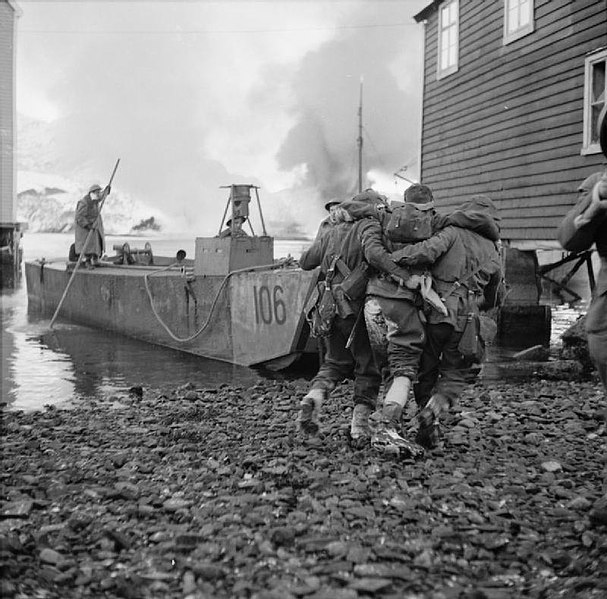 Western Desert Campaign - Operation Crusader Western Desert Campaign - Operation CrusaderAfter all his infantry have arrived along the coast road, Rommel withdraws his armored rearguard to Agedabia (where his advance towards Egypt started in April). British 22nd Armored Brigade follows close behind, recently re-equipped with new tanks. At 2.29 PM 20 miles East of Tobruk, Libya, 1 torpedo from U-559 stops Polish SS Warszawa carrying Allied troops to Tobruk from Alexandria, Egypt (4 crew and 19 passengers killed). 445 survivors taken off by British corvette HMS Peony which attempts to tow the damaged ship. At 7.30 PM, U-559 sinks SS Warszawa with a coup de grâce. United StatesLieutenant General John DeWitt, Commanding General Fourth Army and Commanding General Western Defense Command, telephones the Provost General in Washington, D.C. to say that the Los Angeles Chamber of Commerce is demanding the internment of all Japanese, citizens or not, in the Southern California area. DeWitt feels such a move would likely alienate loyal Japanese. United States/United Kingdom relationsBritish Prime Minister Winston Churchill, in Washington for the Arcadia Conference, addresses a joint session of the U.S. Congress. He warns that "many disappointments and unpleasant surprises await us" and that the war will last at least another 18 months. YouTube (Churchill Speech To Congress - December 1941)Pacific WarCHINA The Tulsa Incident occurred in Burma on 19 December when a U.S. officer asked the Government of Burma to impound lend-lease material at Rangoon, much of which was in the freighter SS Tulsa in the harbor, pending a decision on its use. This incident ends today with a conciliatory meeting between Generalissimo Chiang Kai-shek and Brigadier General John Magruder, head of the American Military Mission to China (AMMISCA), during which it is agreed to send an AMMISCA officer to Rangoon. MALAYA Ipoh is evacuated by Indian 11th Division troops, but the Indian 12th Brigade Group fights a rear-guard action at Chemor, to the north. Photo: Sembawan, Singapore, Malaya. Australian built Beaufort bomber aircraft refuelling on arrival in Malaya, some hands in the crowd holding up the hose from the tanker. These aircraft are fast and highly maneouvrable but were unarmed. Of the six that were flown to Malaya, five returned to Australia with one being kept for reconnaissance purposes MIDWAY ISLANDS USN seaplane tender USS Tangier, diverted from the attempt to relieve Wake Island, disembarks Battery B, 4th Marine Defense Battalion and the ground echelon of Marine Fighting Squadron Two Hundred Twenty One at Midway to augment that garrison's defenses. Photo: Tangier unloads supplies at Midway, 26 December 1941; USS Ralph Talbot(DD-390) and USS Blue(DD-387) are at left; Tamaha(YN-440) is in the background, center. Tangier had originally been earmarked for the Wake Island relief expedition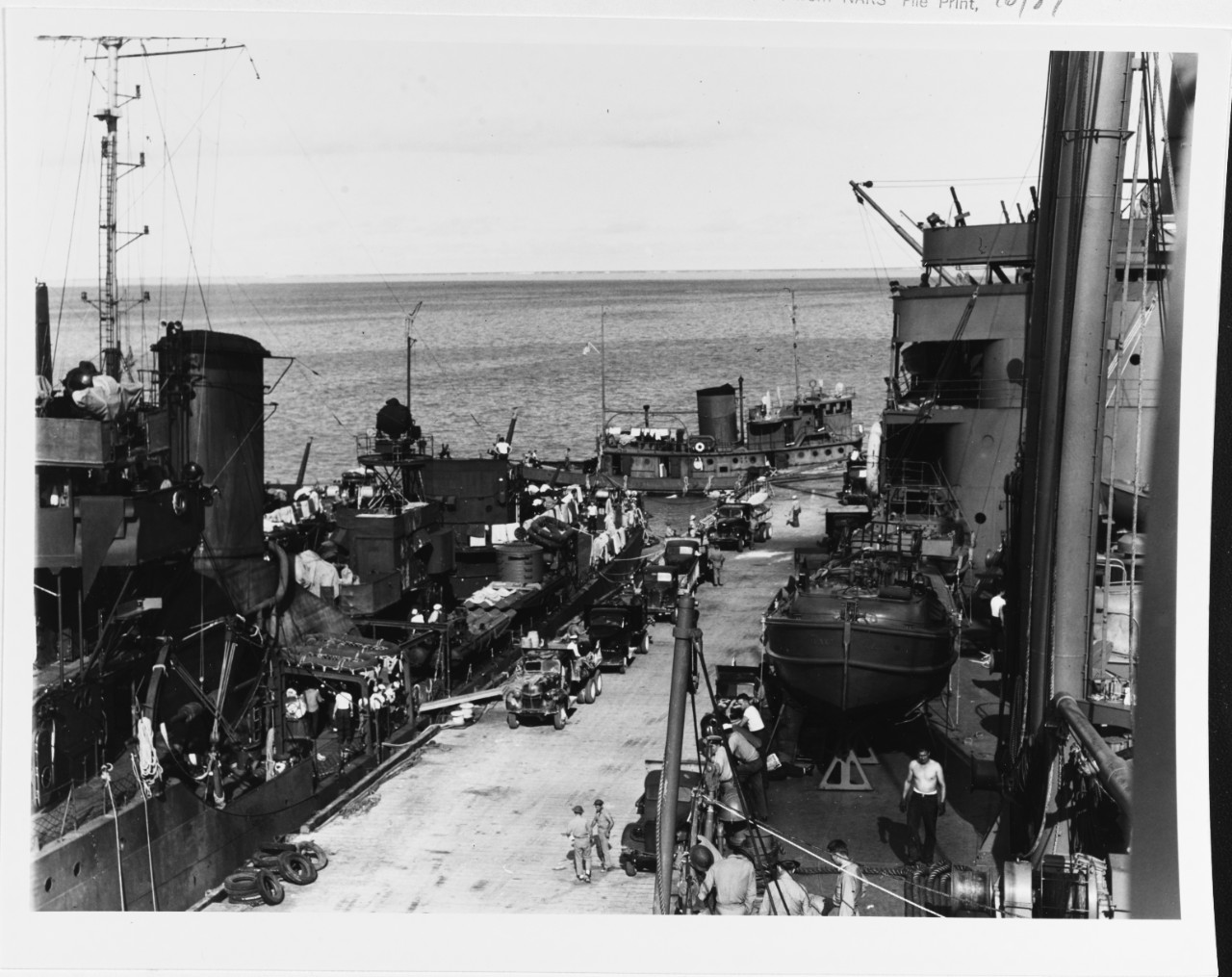 PHILIPPINE ISLANDS Manila, is declared an open city but Japanese bombing continues unabated. USN defense forces under Rear Admiral Francis W. Rockwell, Commander of the Sixteenth Naval District and the Philippine Naval Coastal Frontier, move to Corregidor Island. The North Luzon Force, except for the 194th Tank Battalion, falls back from the Agno River to the line Santa Ignacia-Guimba- -San Jose. The South Luzon Force continues to withdraw in two columns and organizes their first line of defense west of Sariaya. Photo: Manila, Philippines is declared an open city 26 Dec 1941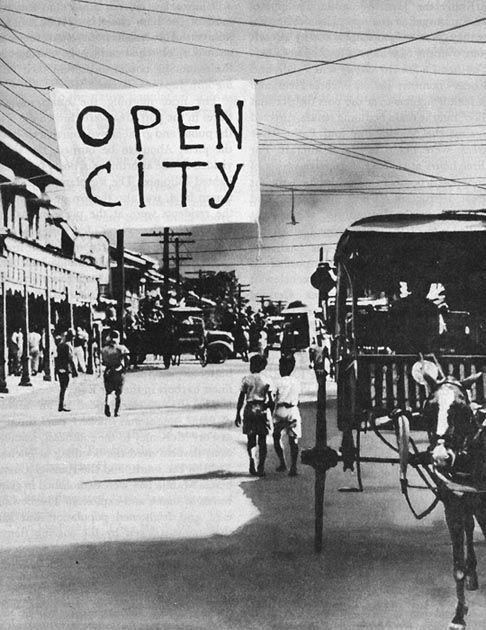 Japanese "Nell" and "Betty" bombers based on Formosa bomb shipping in Manila Bay; the USN destroyer USS Peary is damaged by near-misses. Motor torpedo boat PT-33, damaged by grounding on 24 December about 53 nautical miles SSW of Manila in position 13.46N, 120.40E, is burned to prevent capture. MacArthur declares Manila to be an "open city" in the hopes of sparing it from attack. MacArthur's tactic fails as the Japanese bomb the city the next day.
|
|

























































